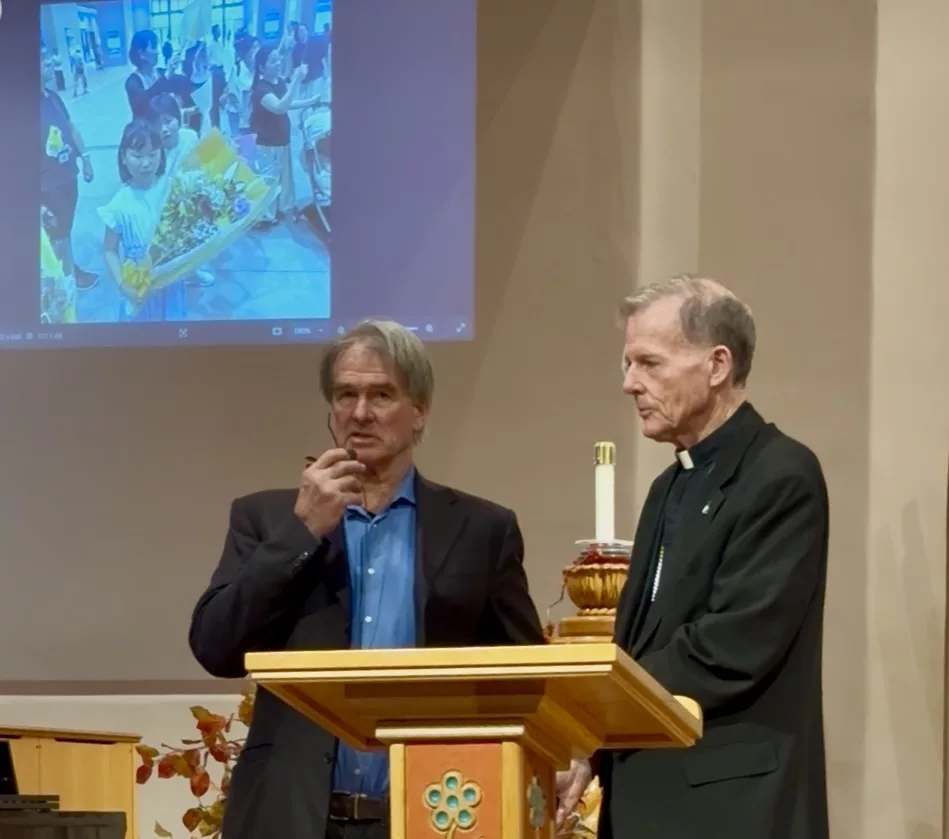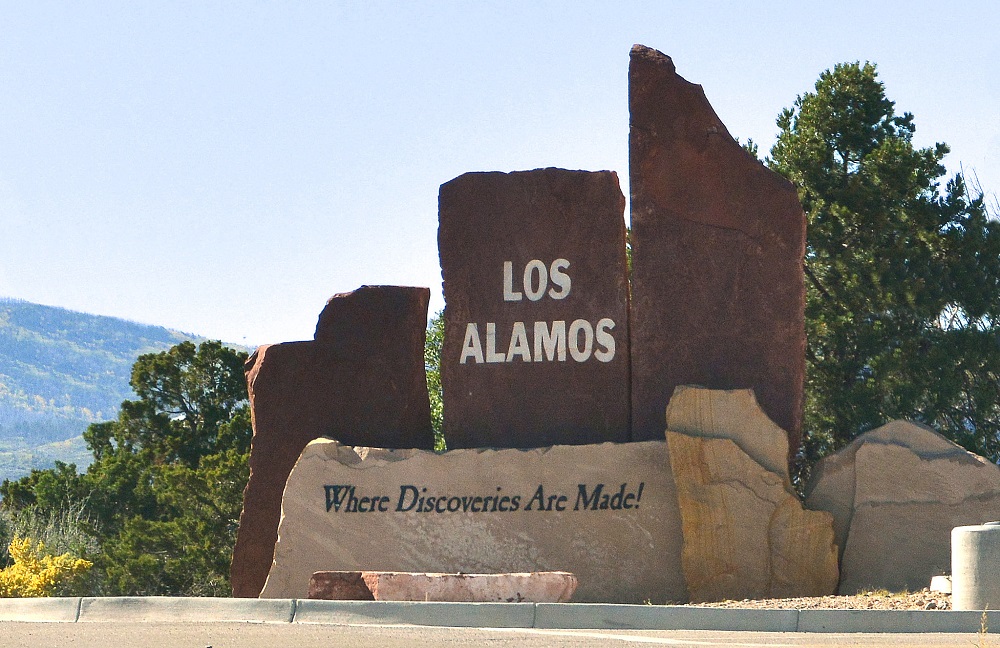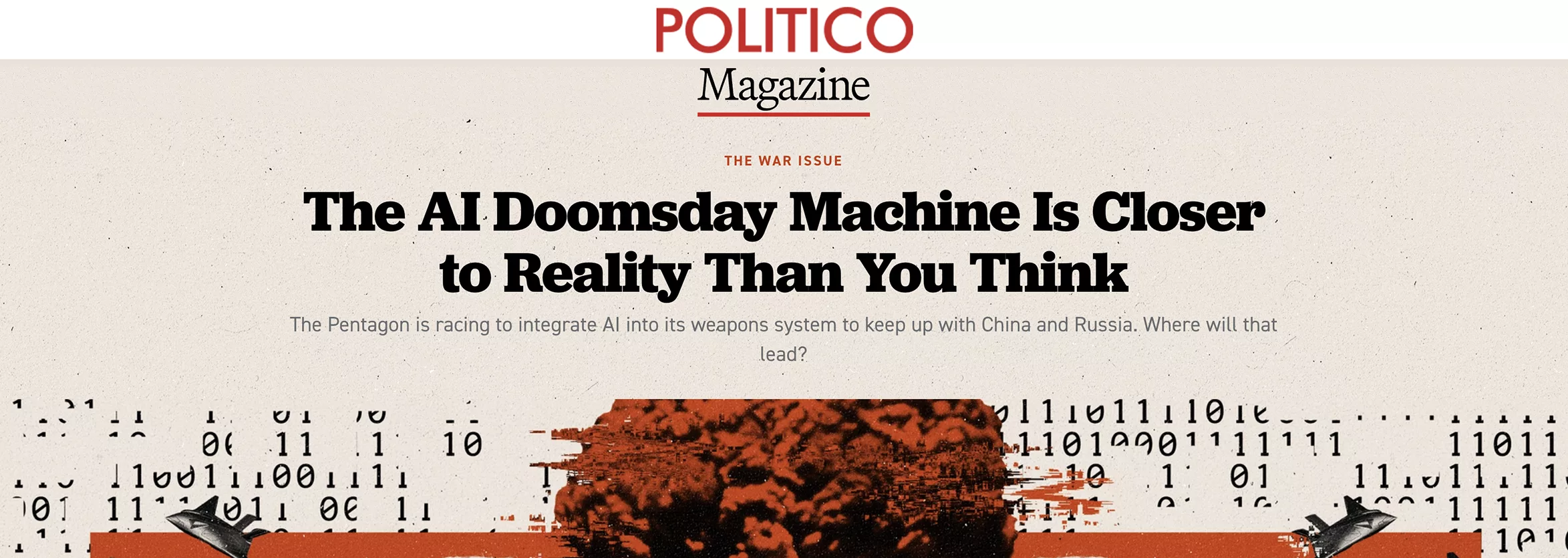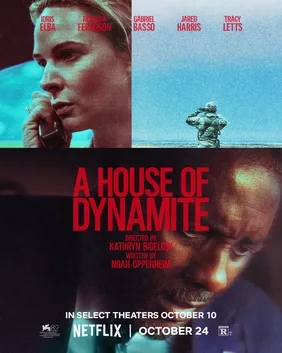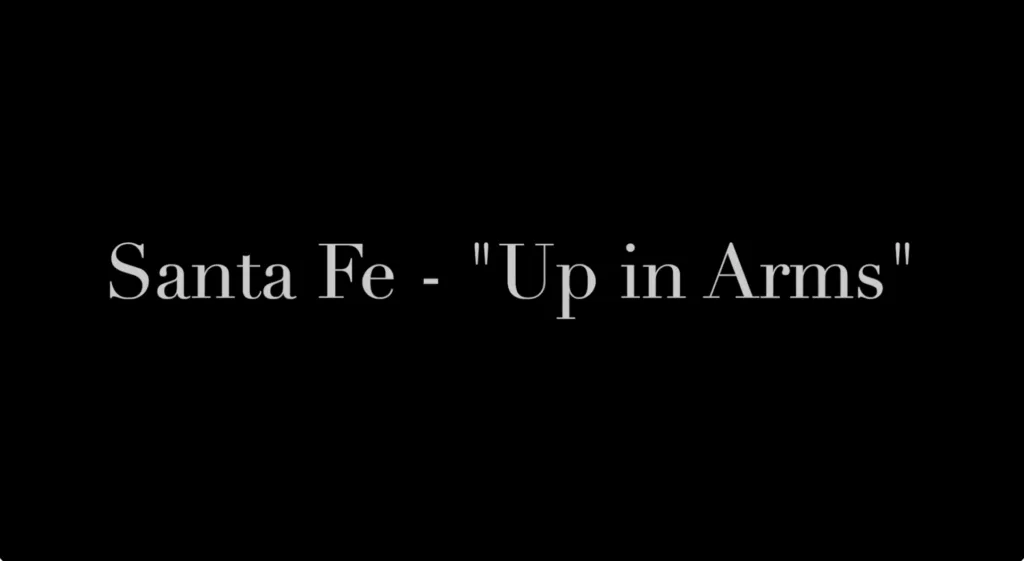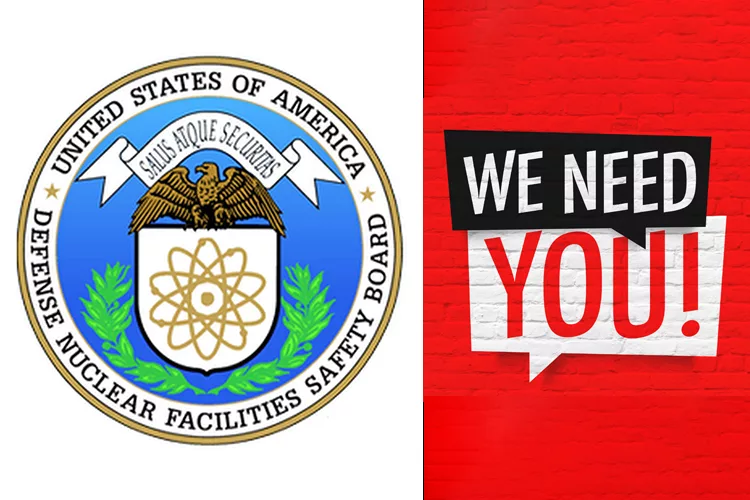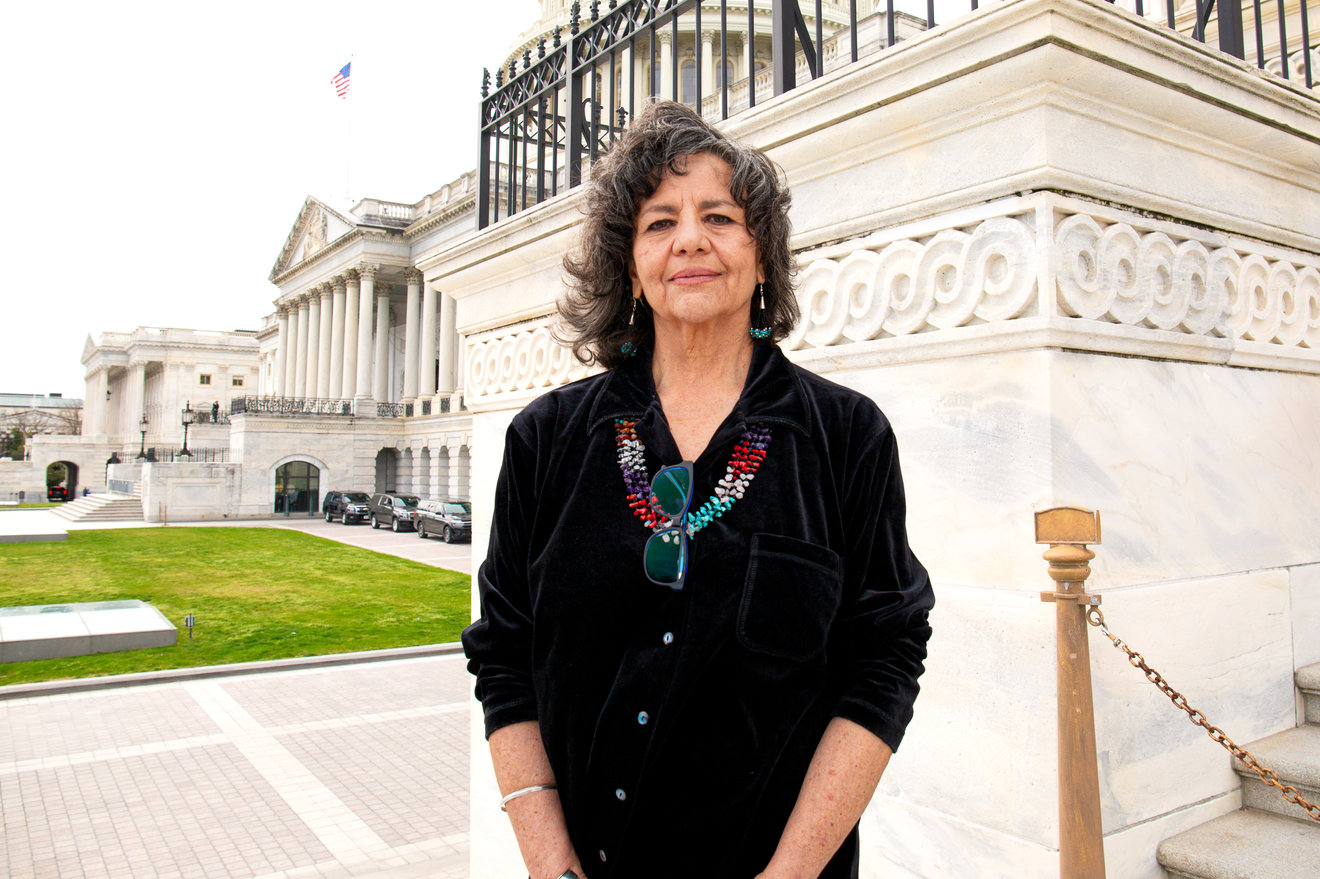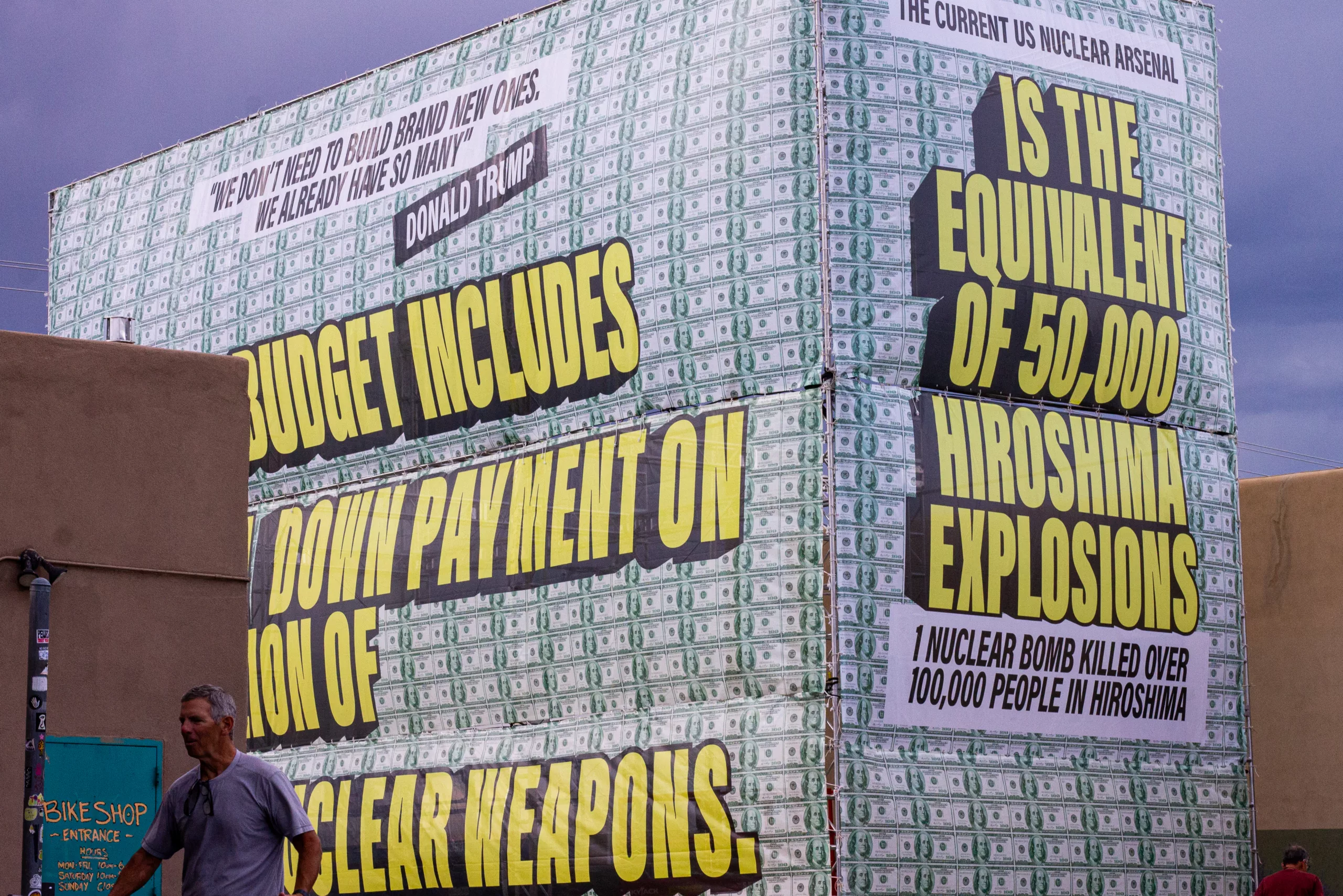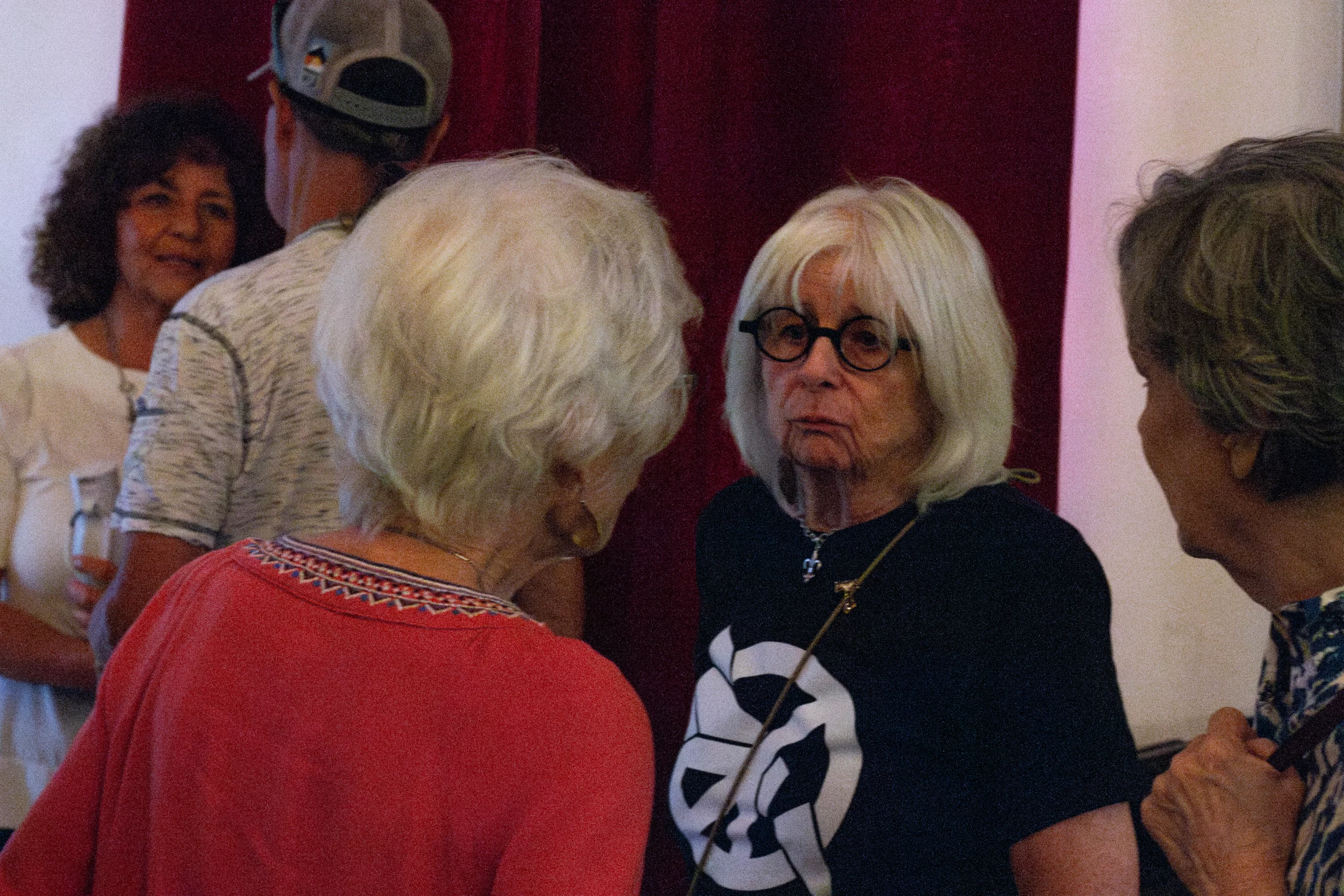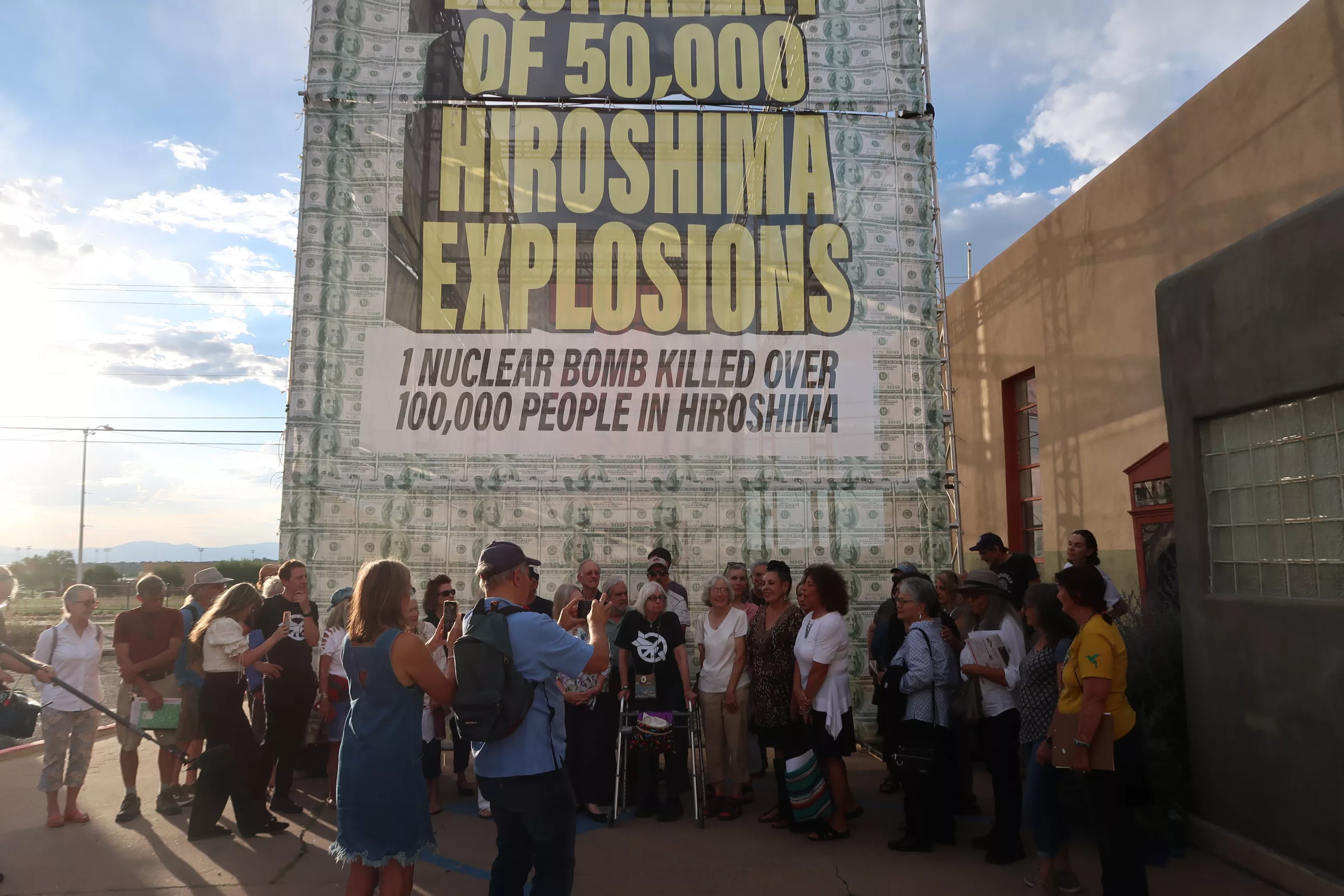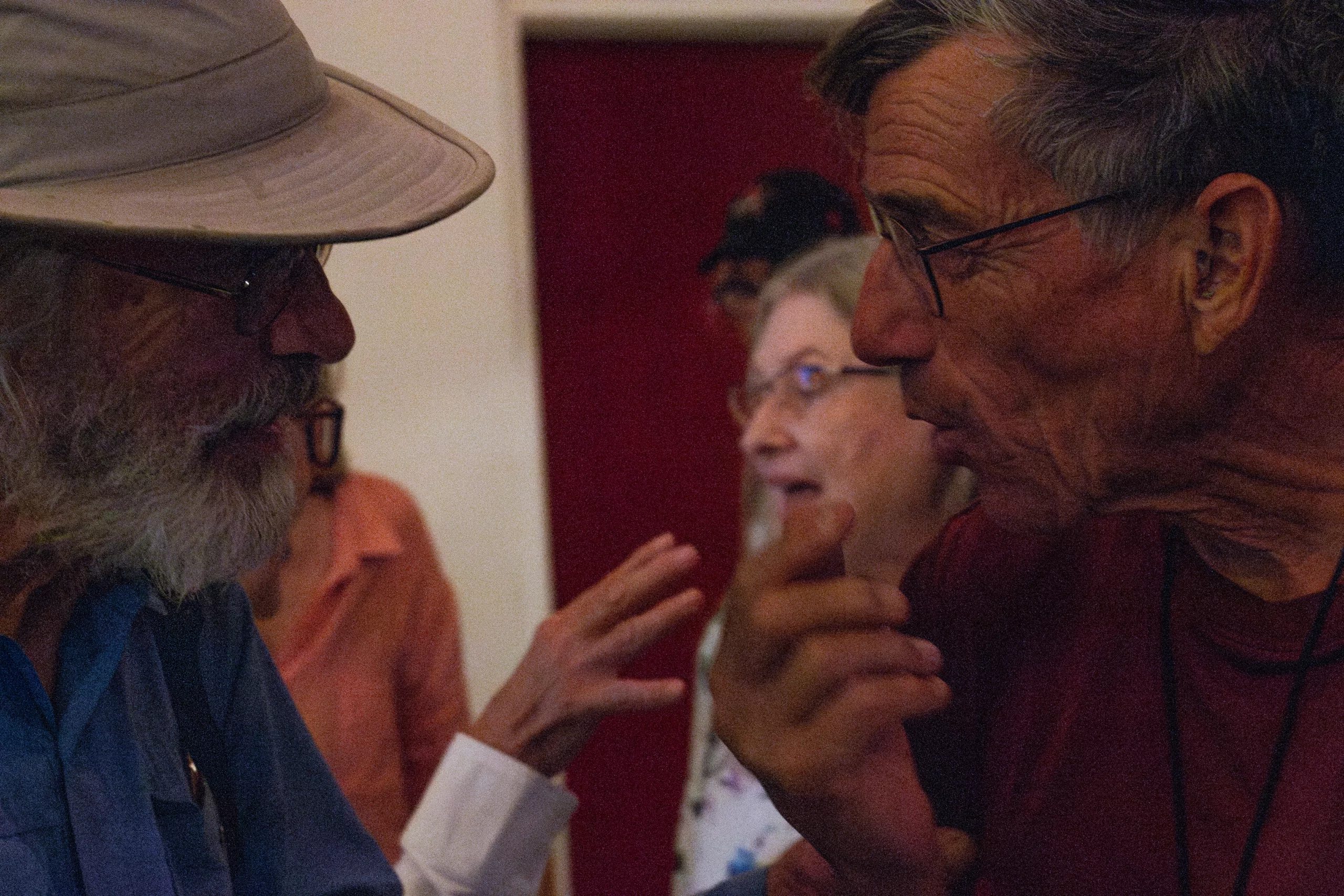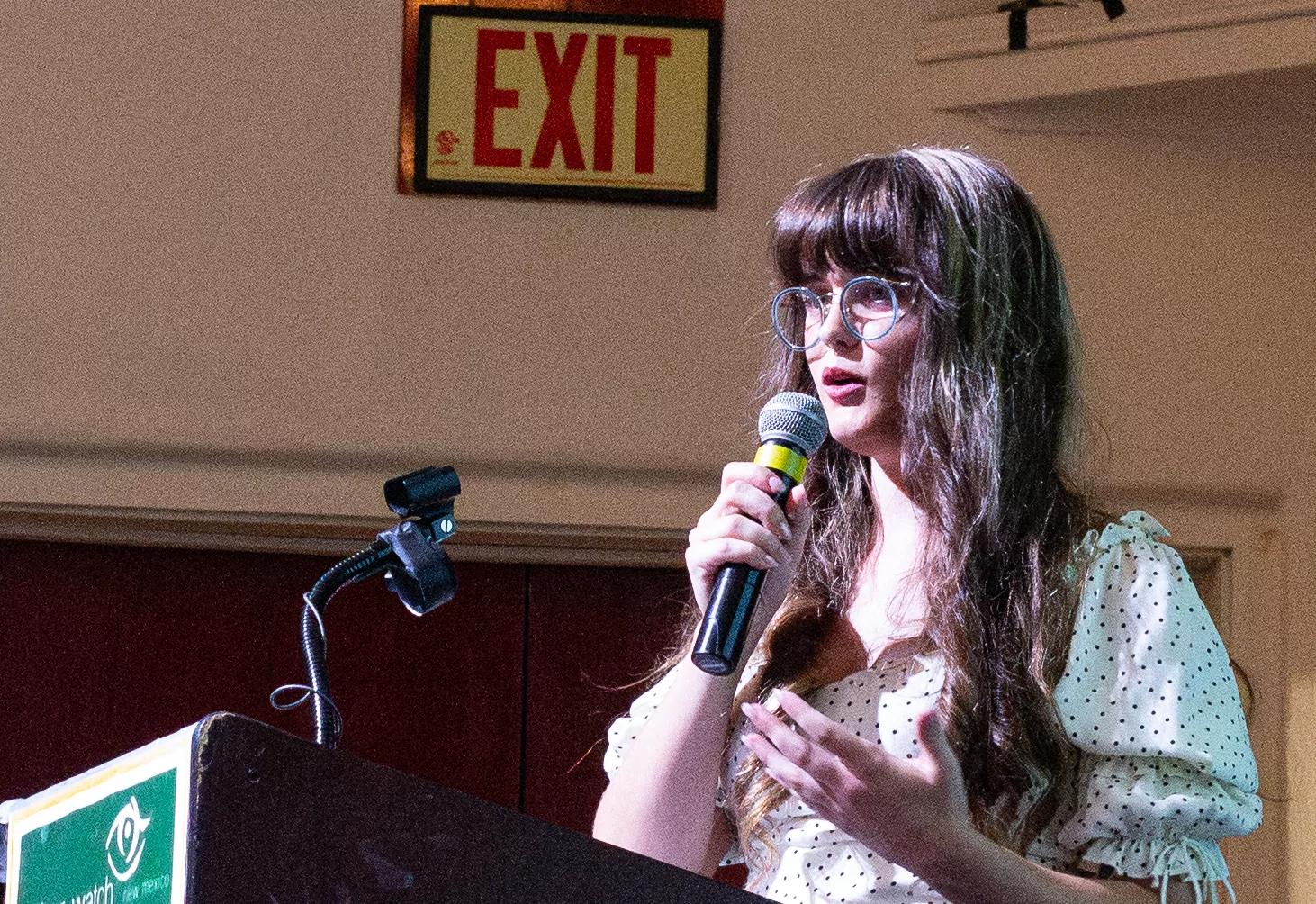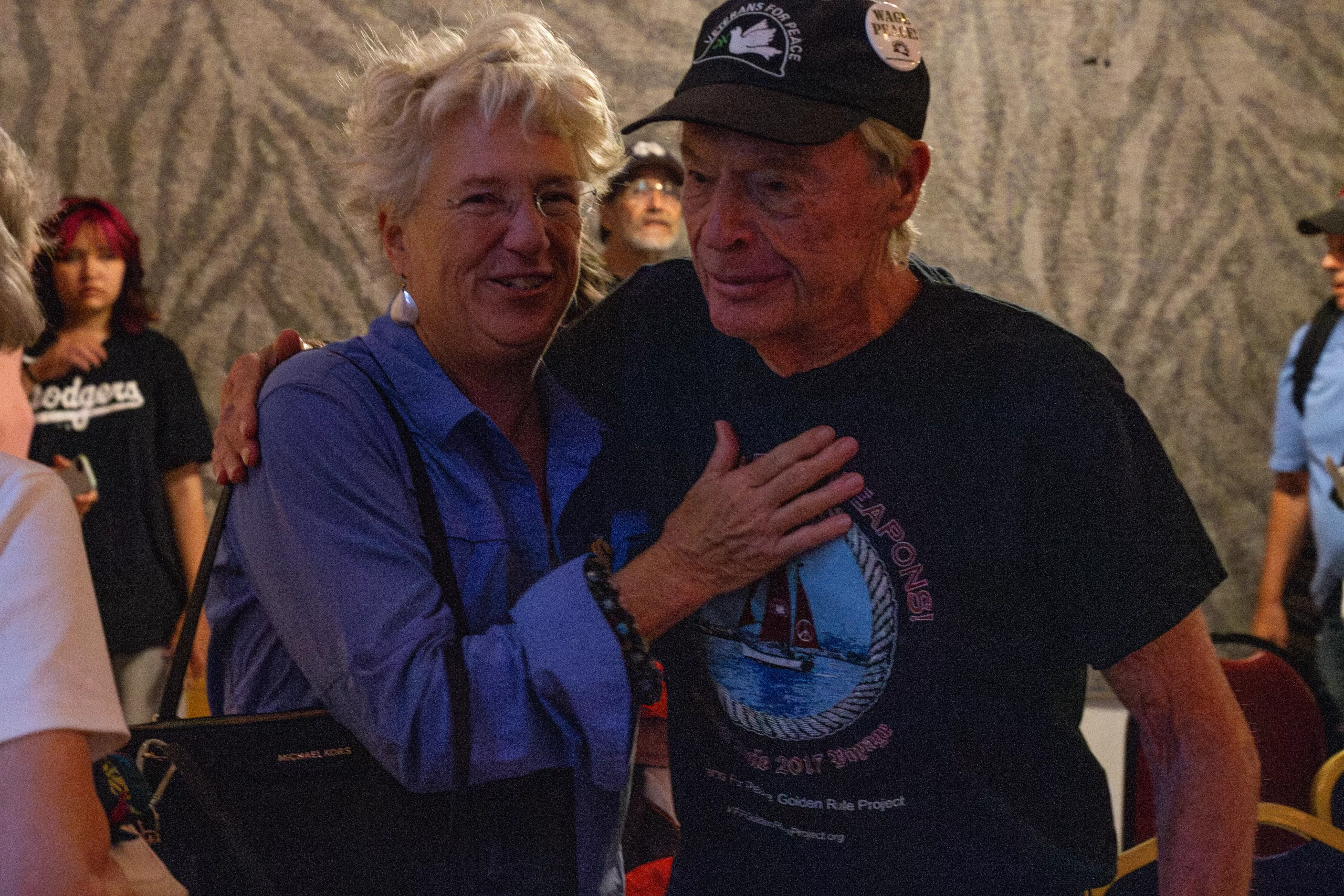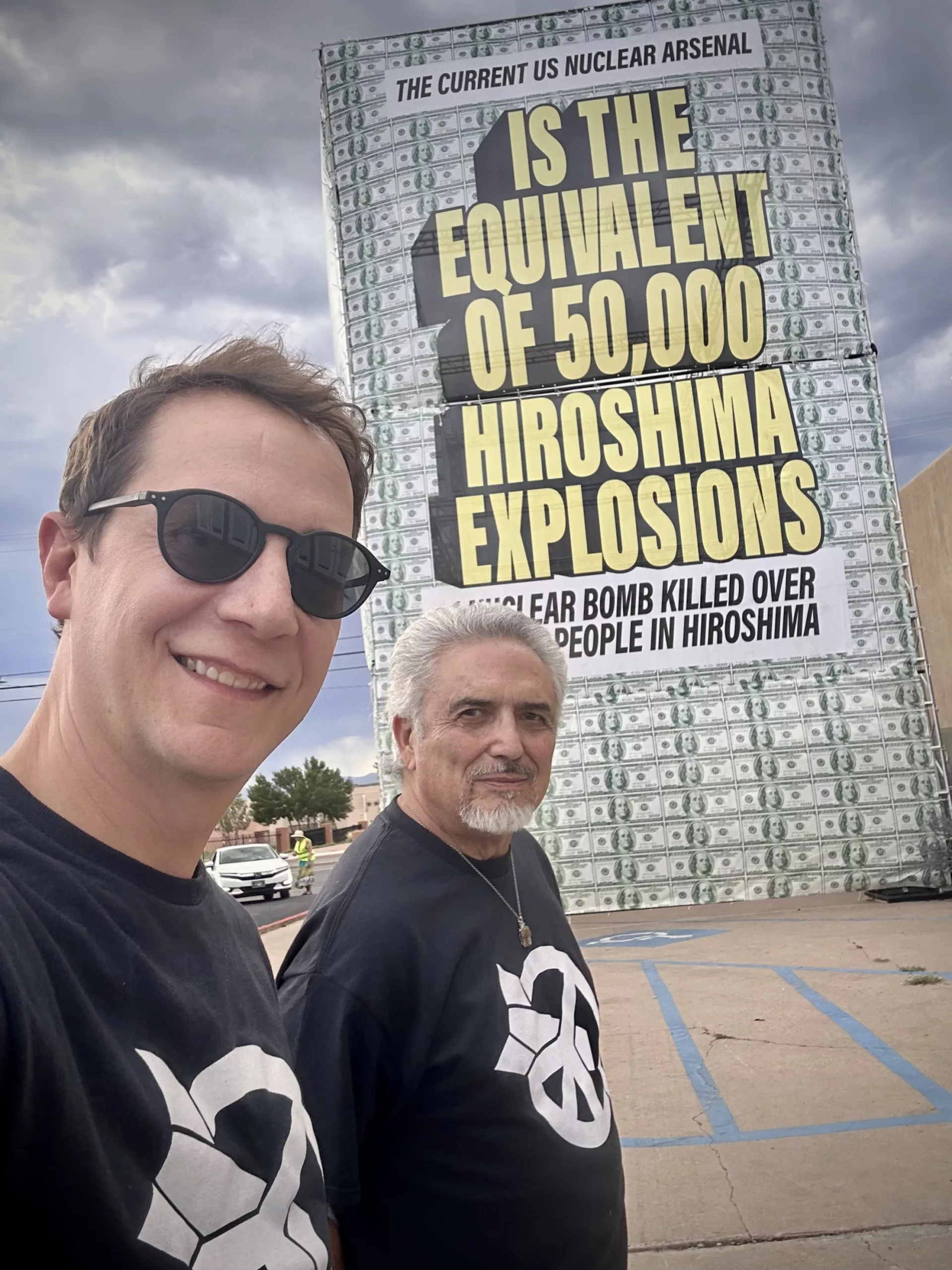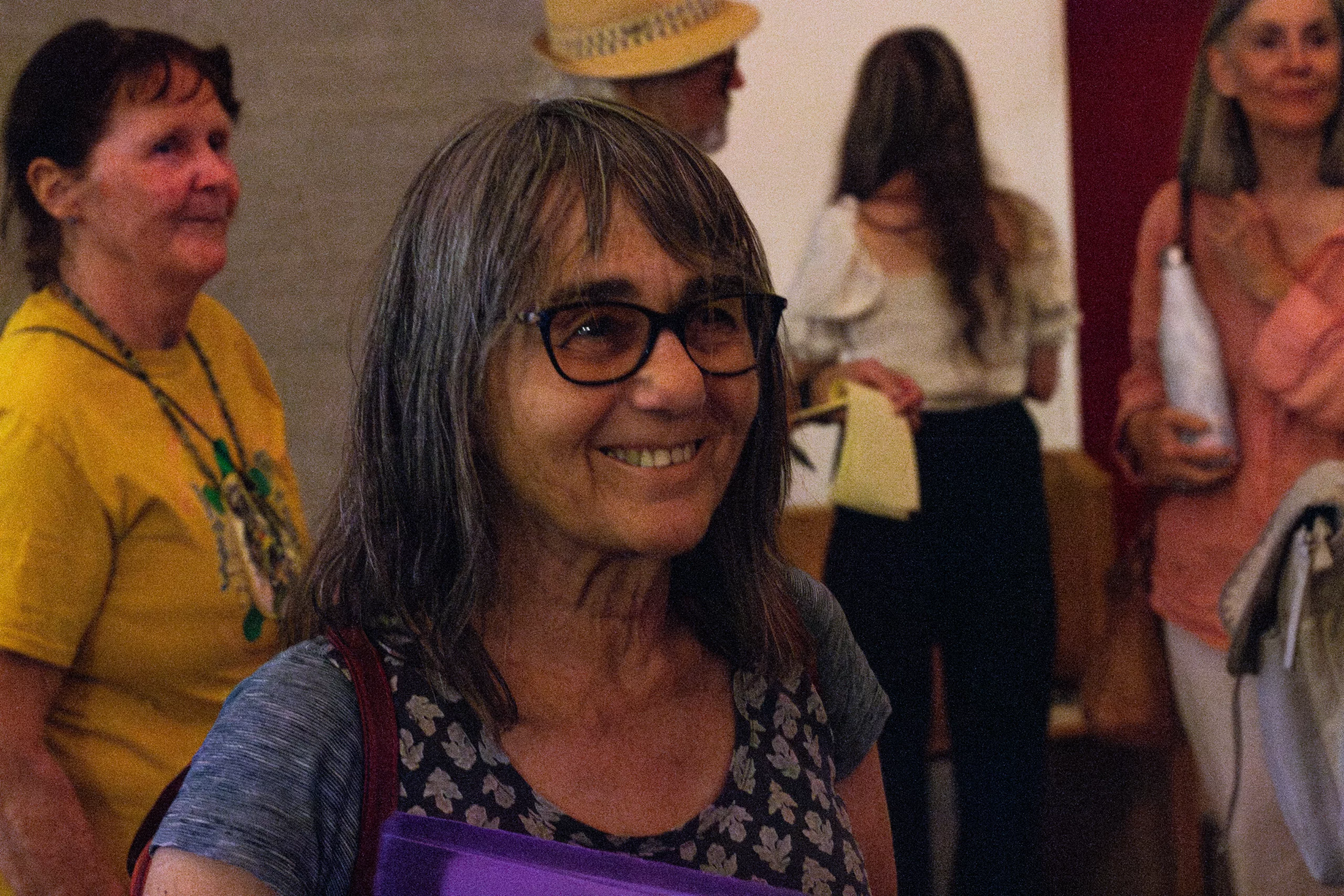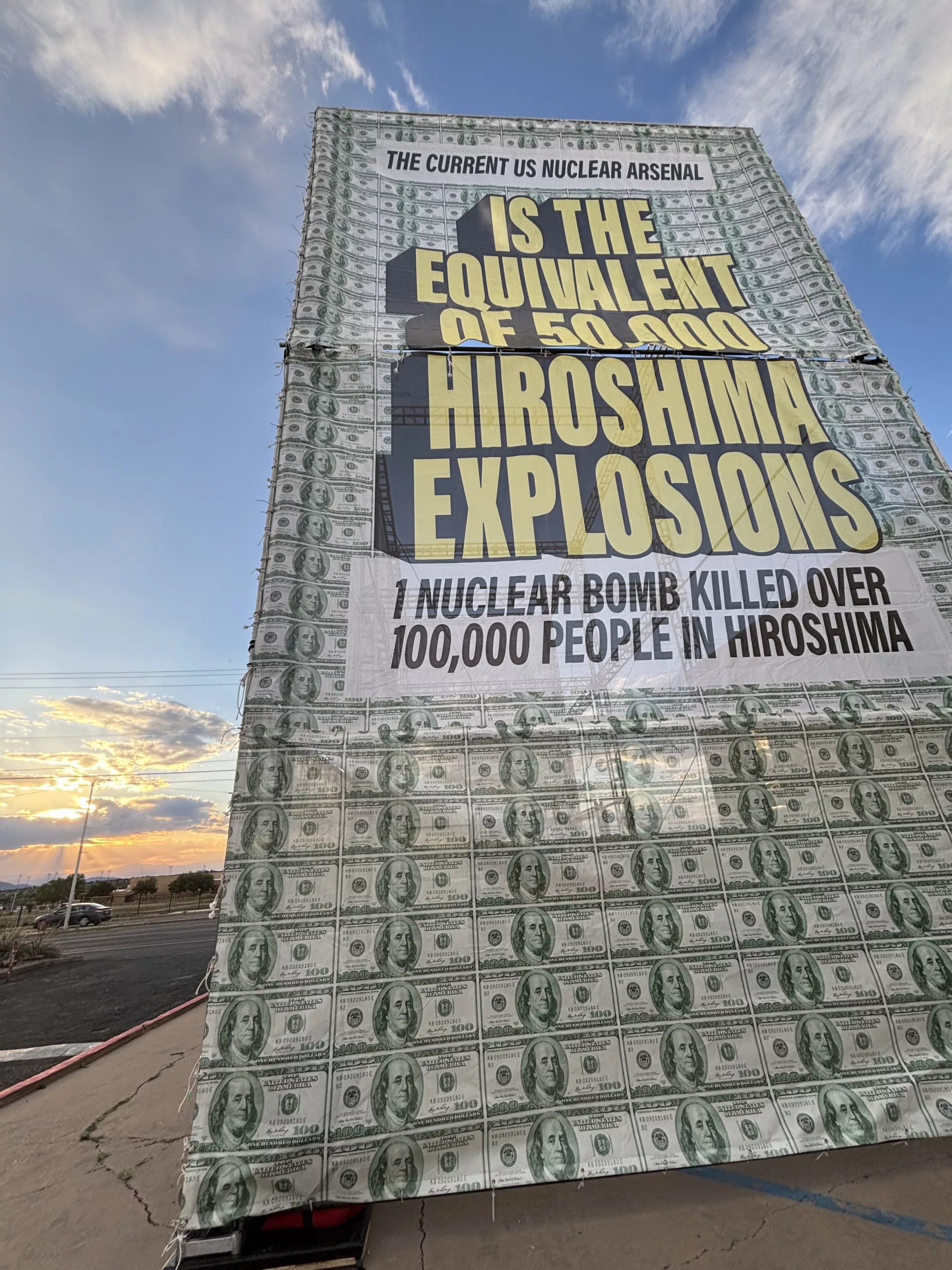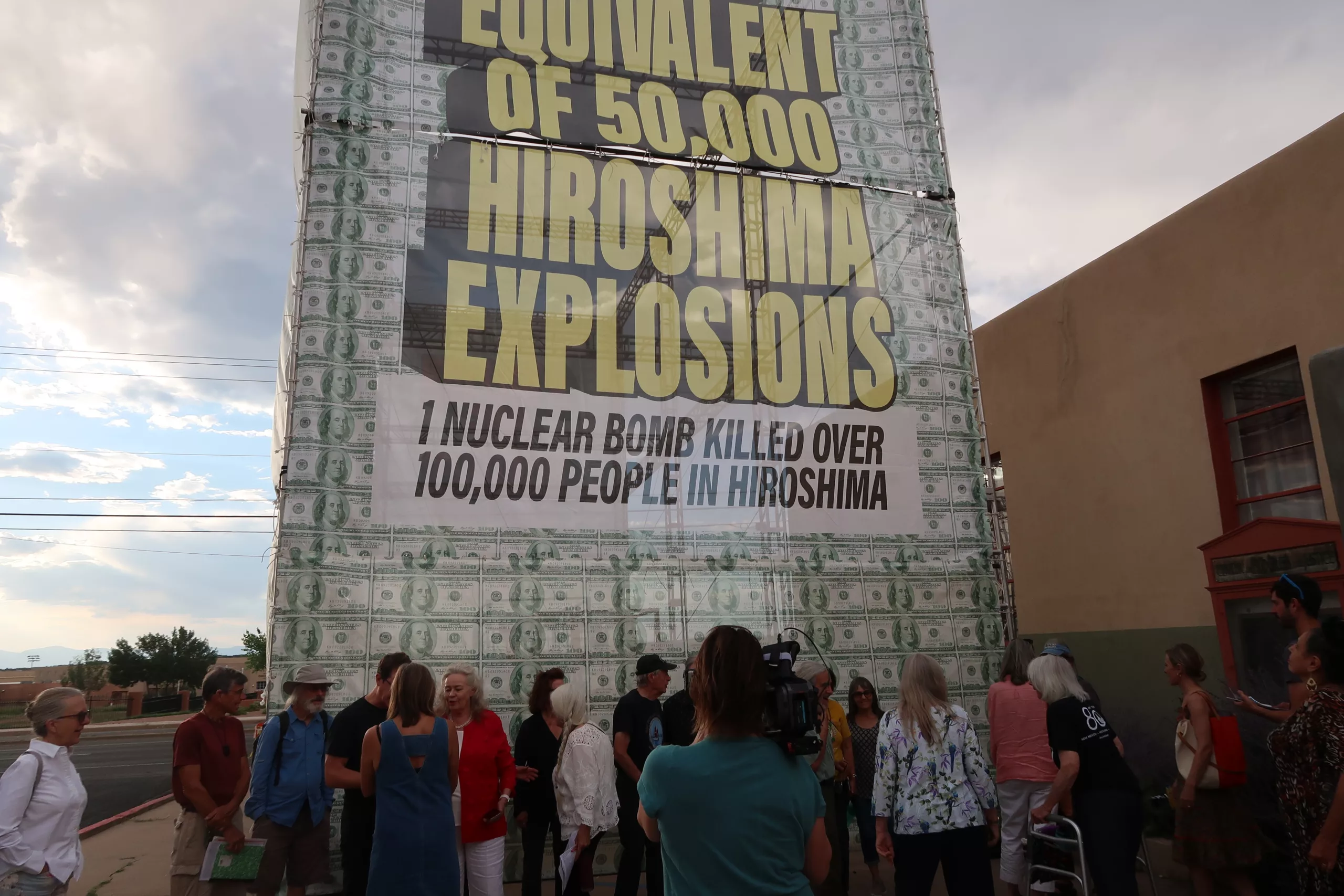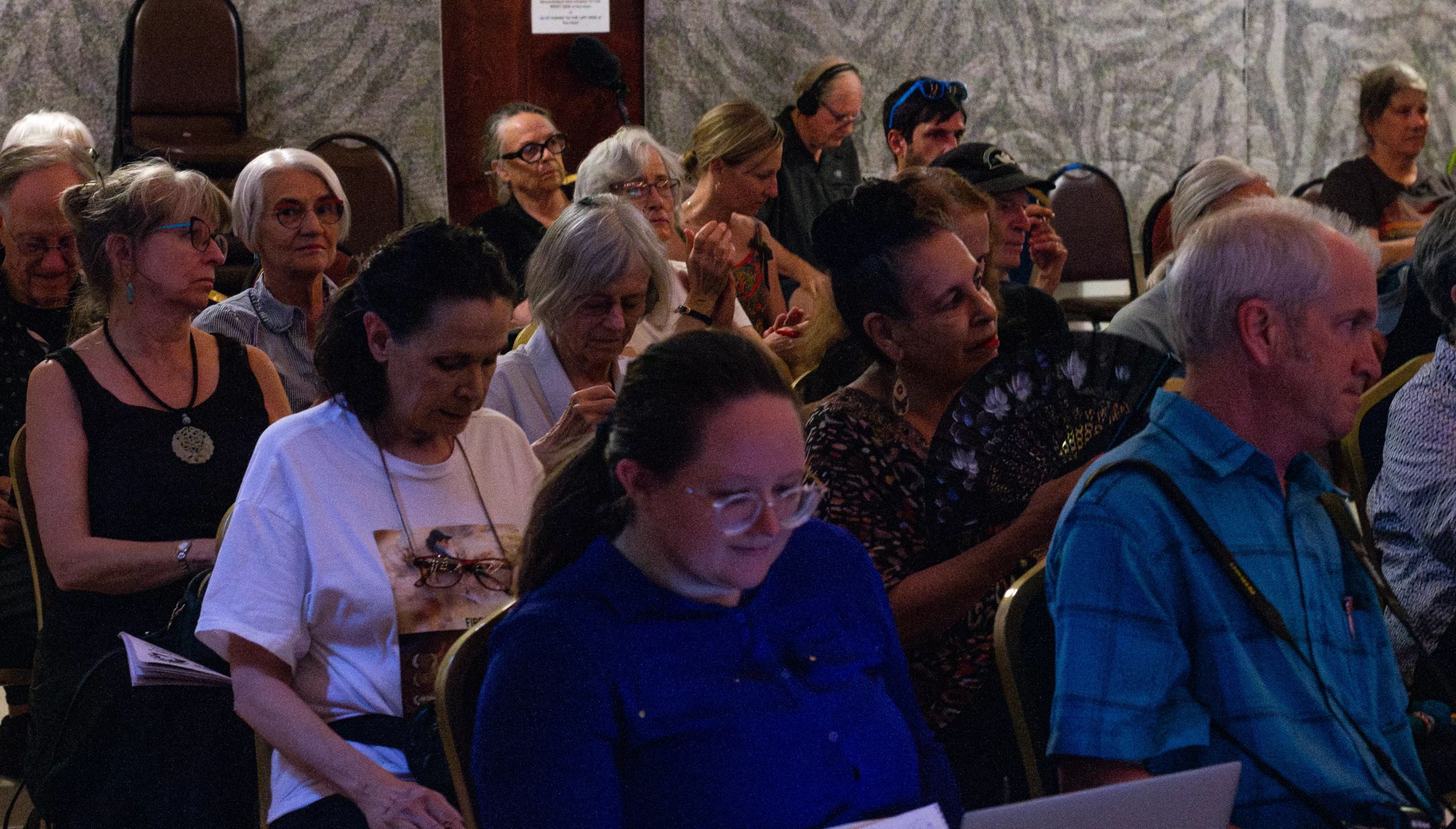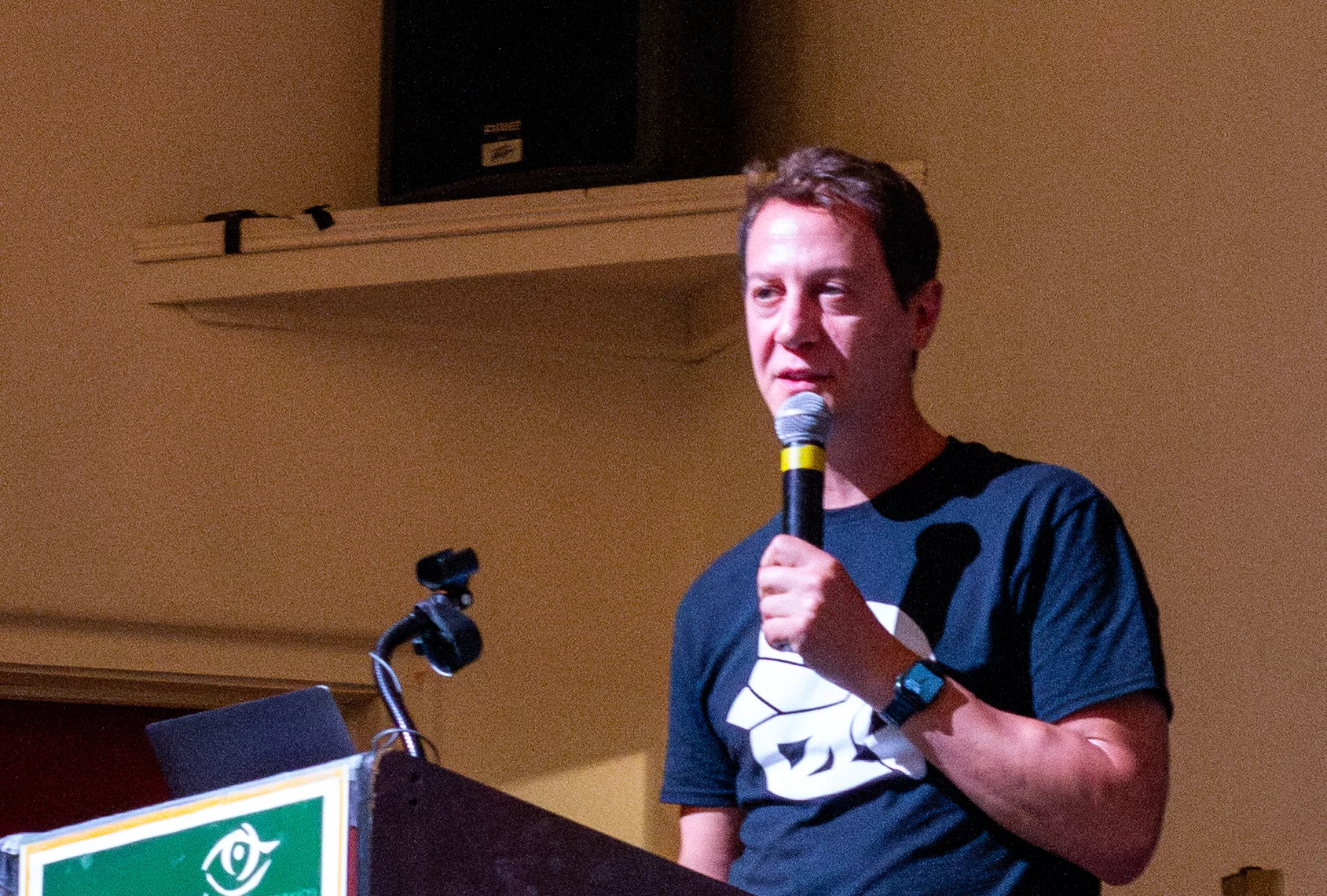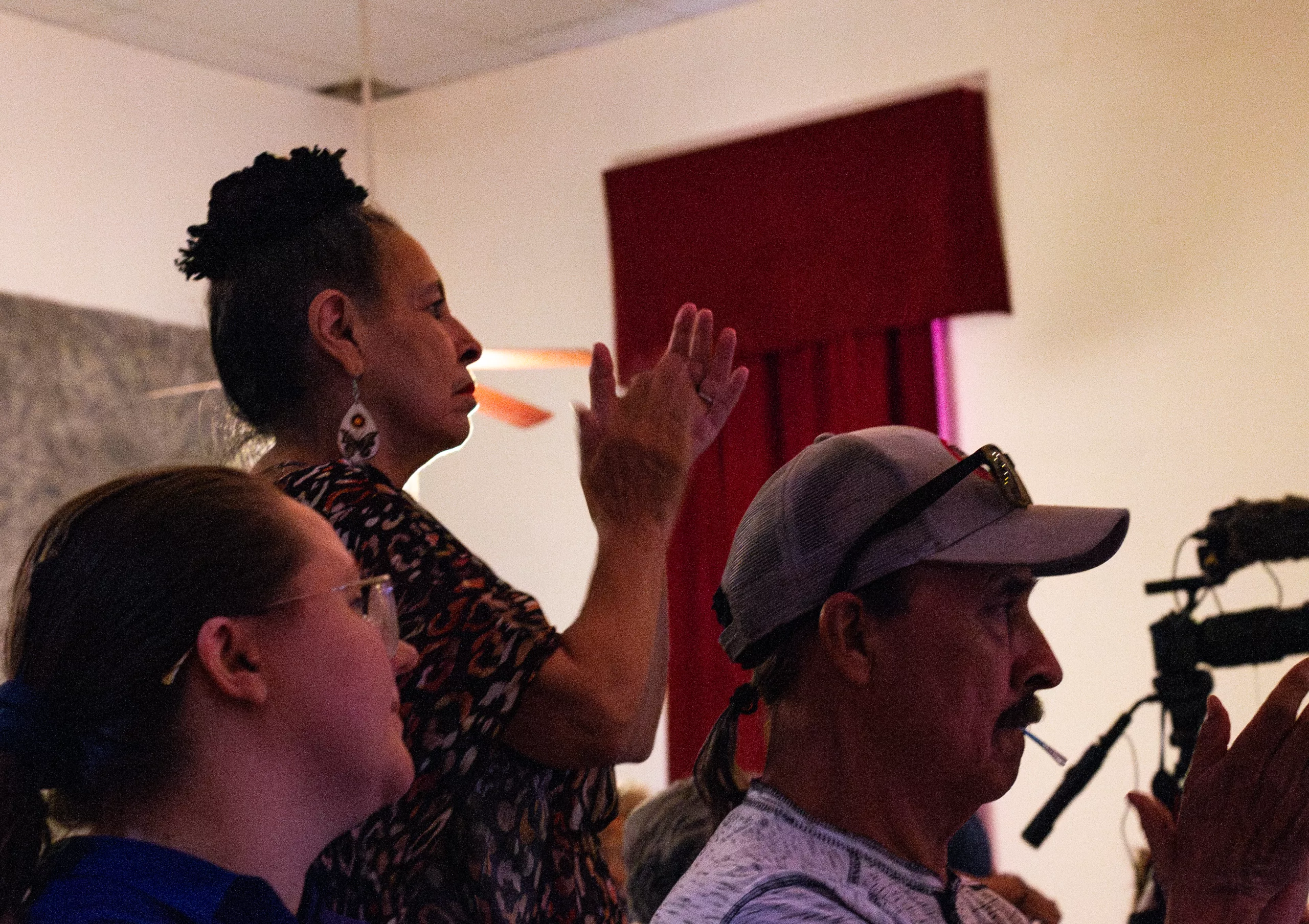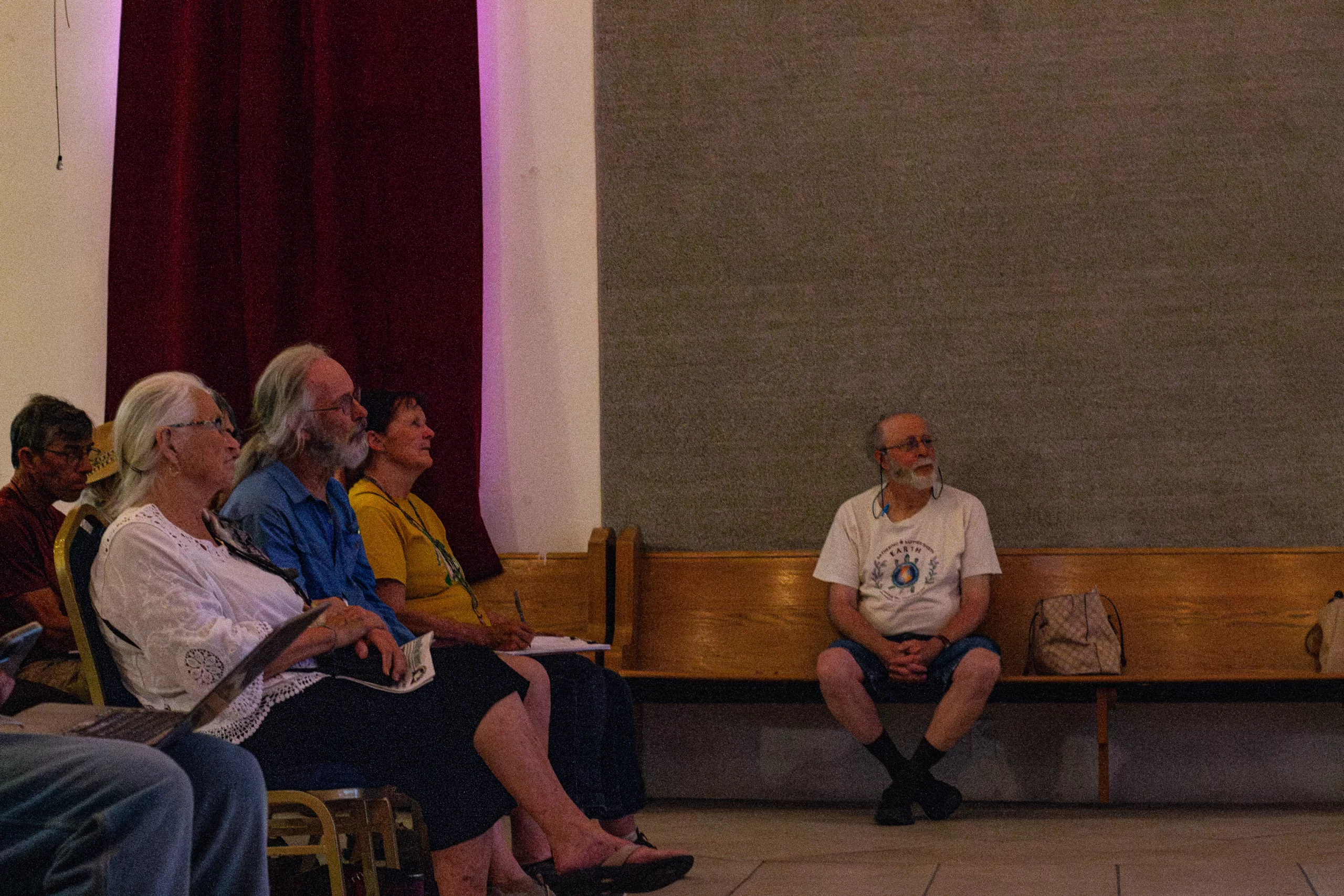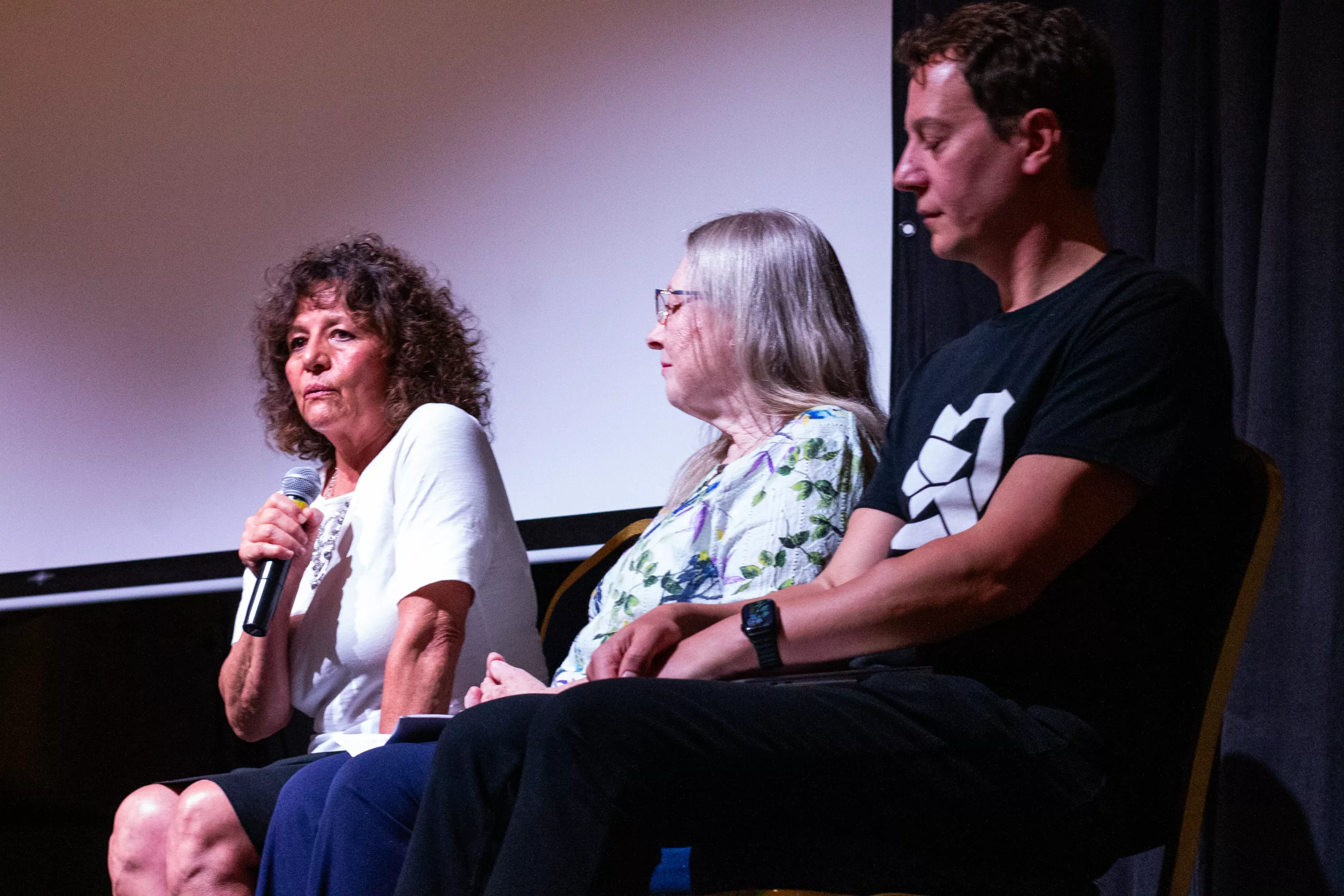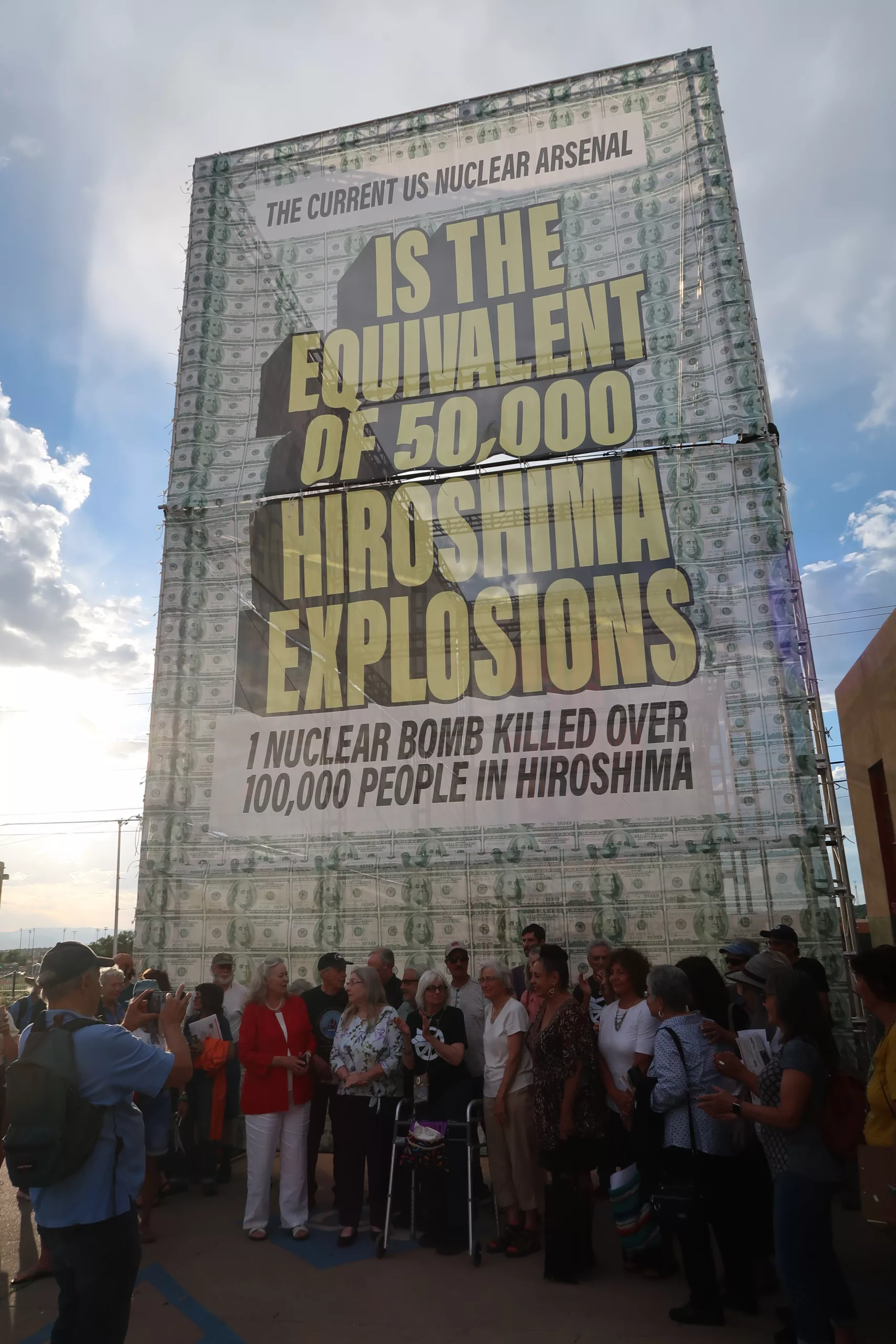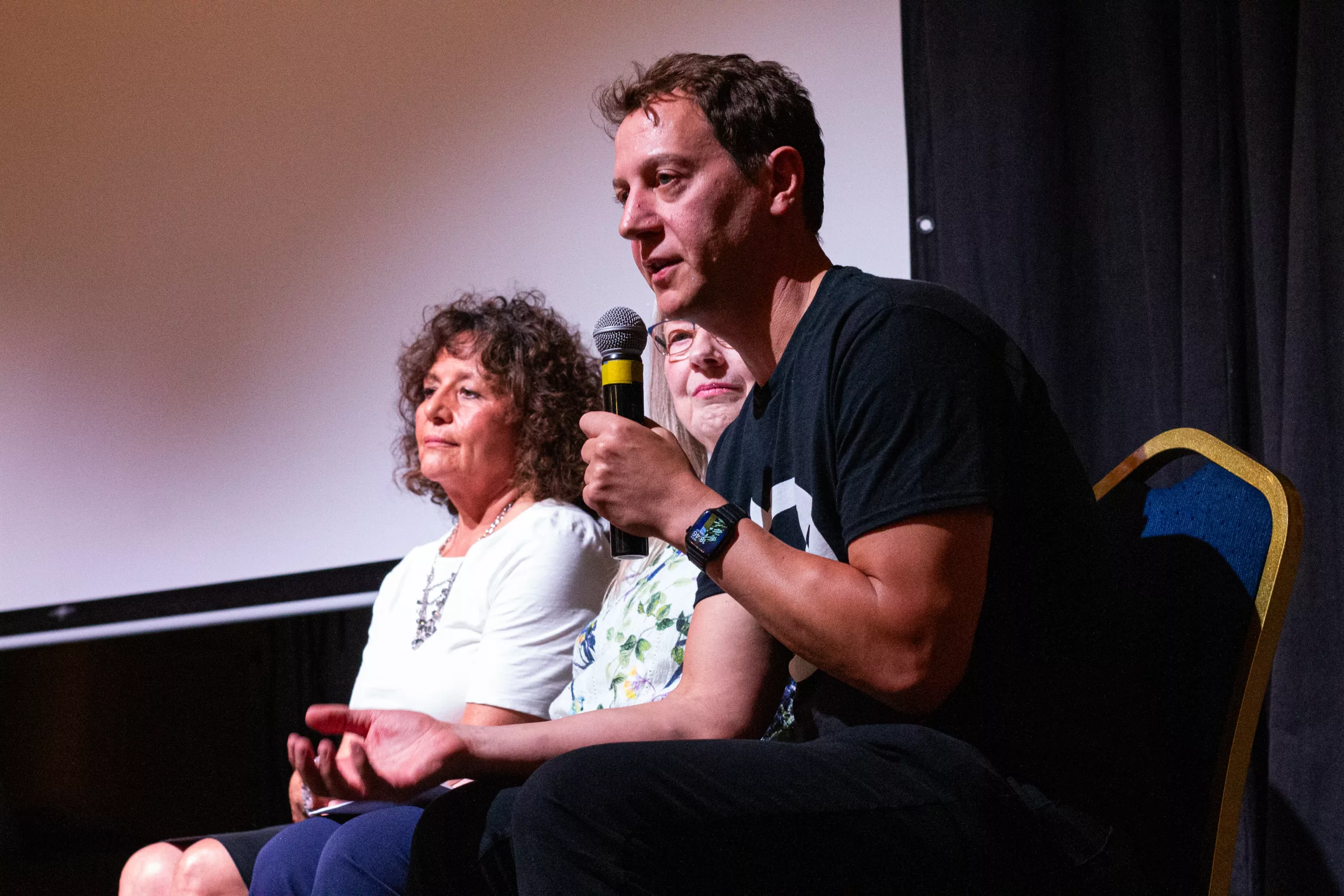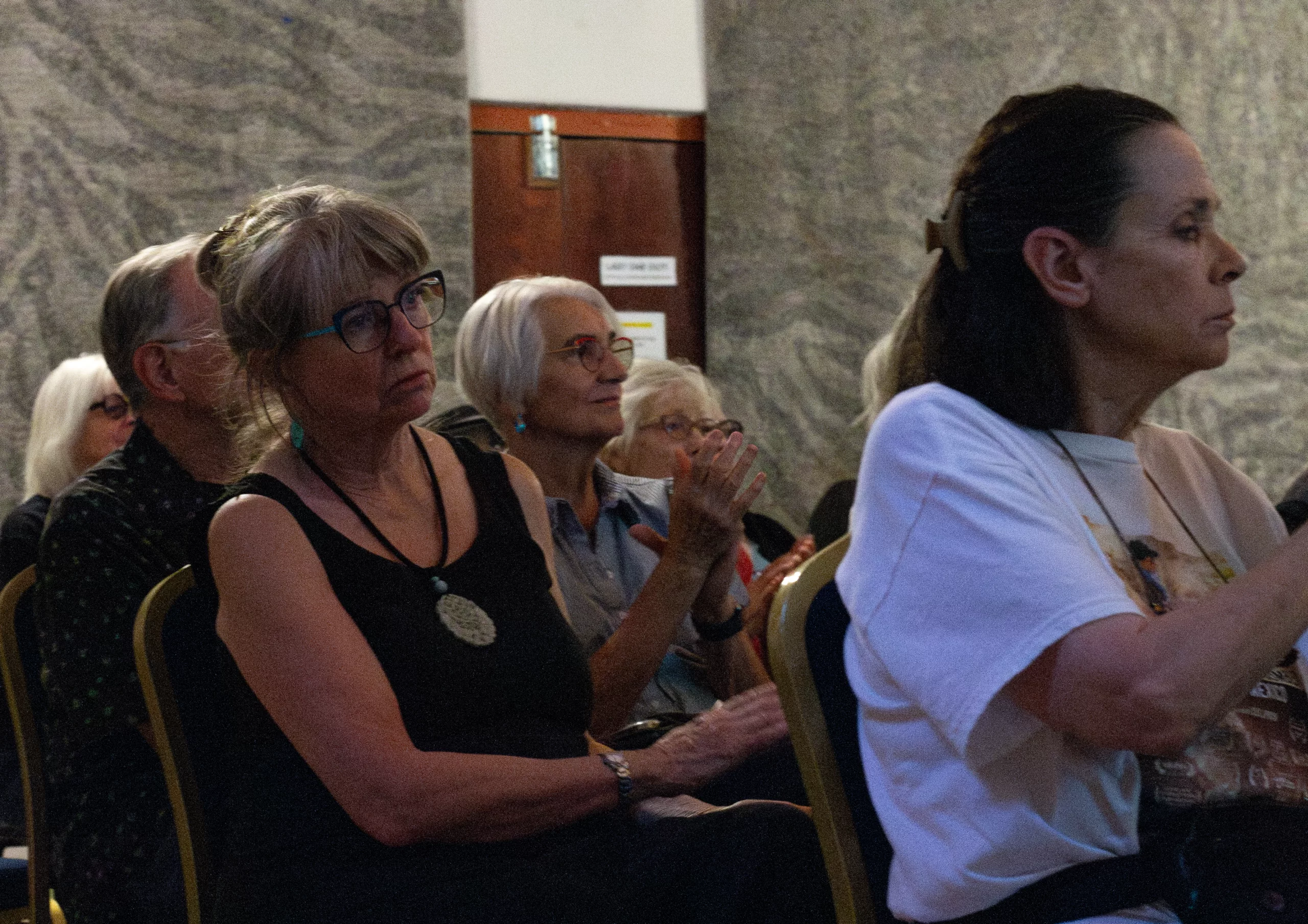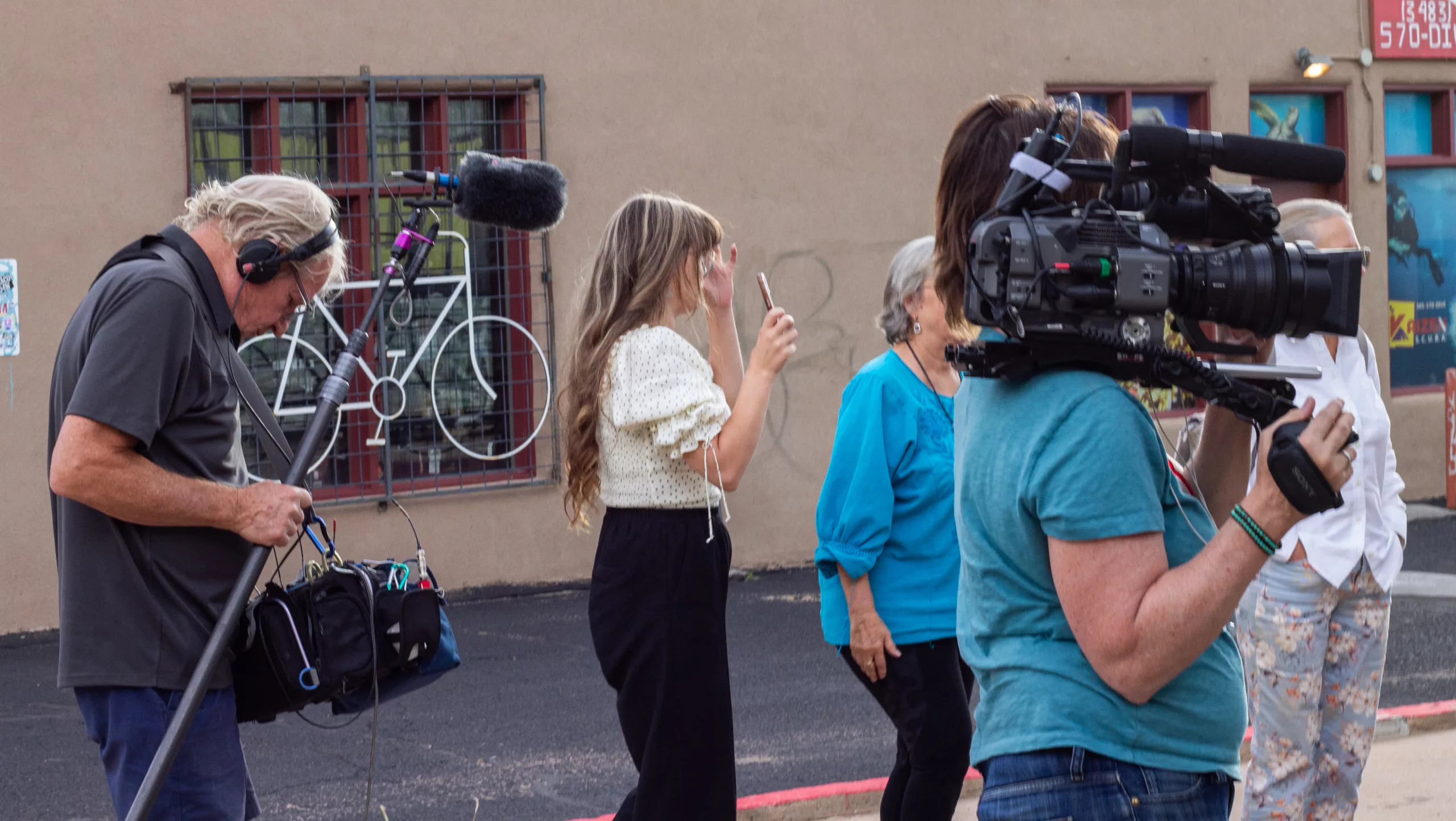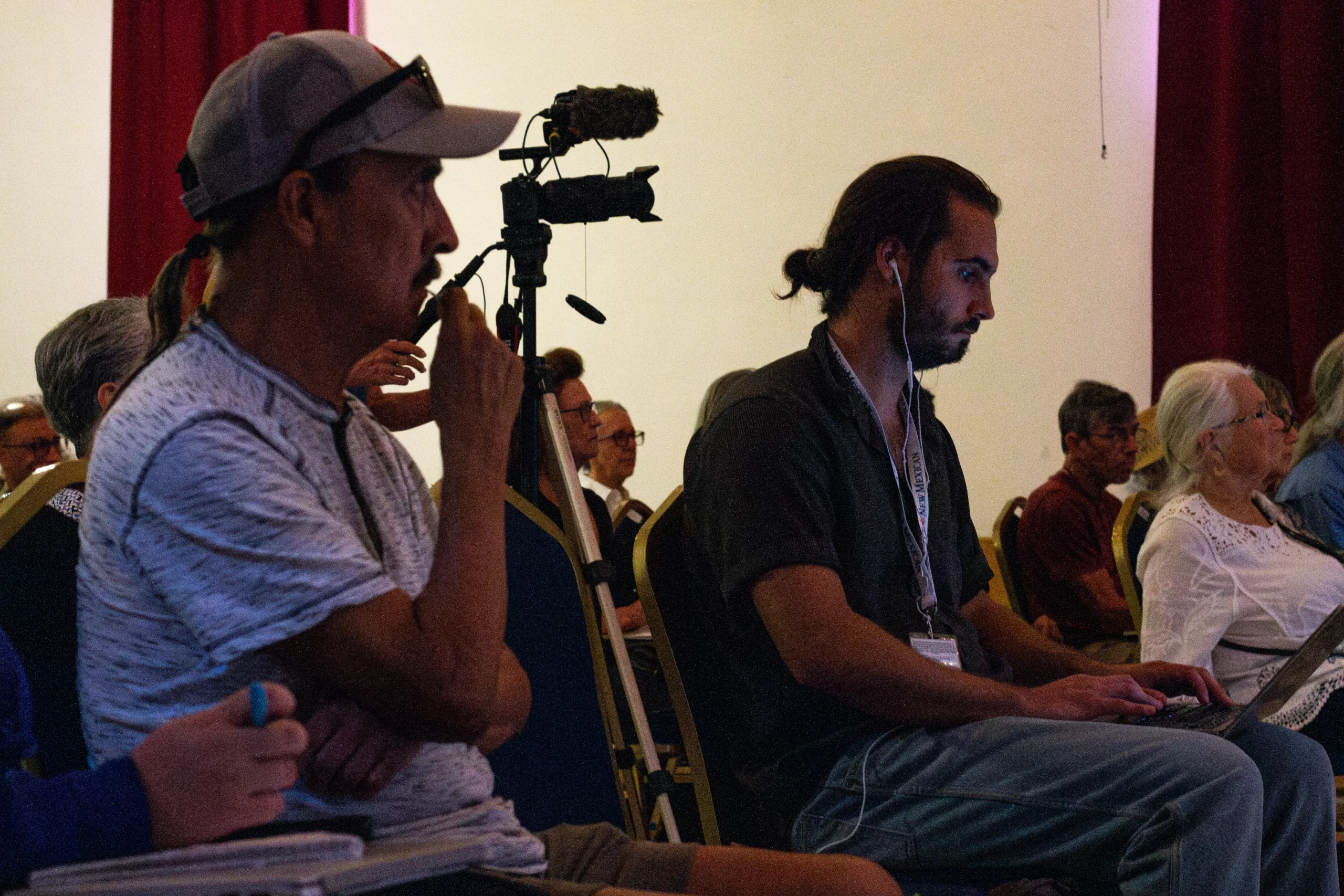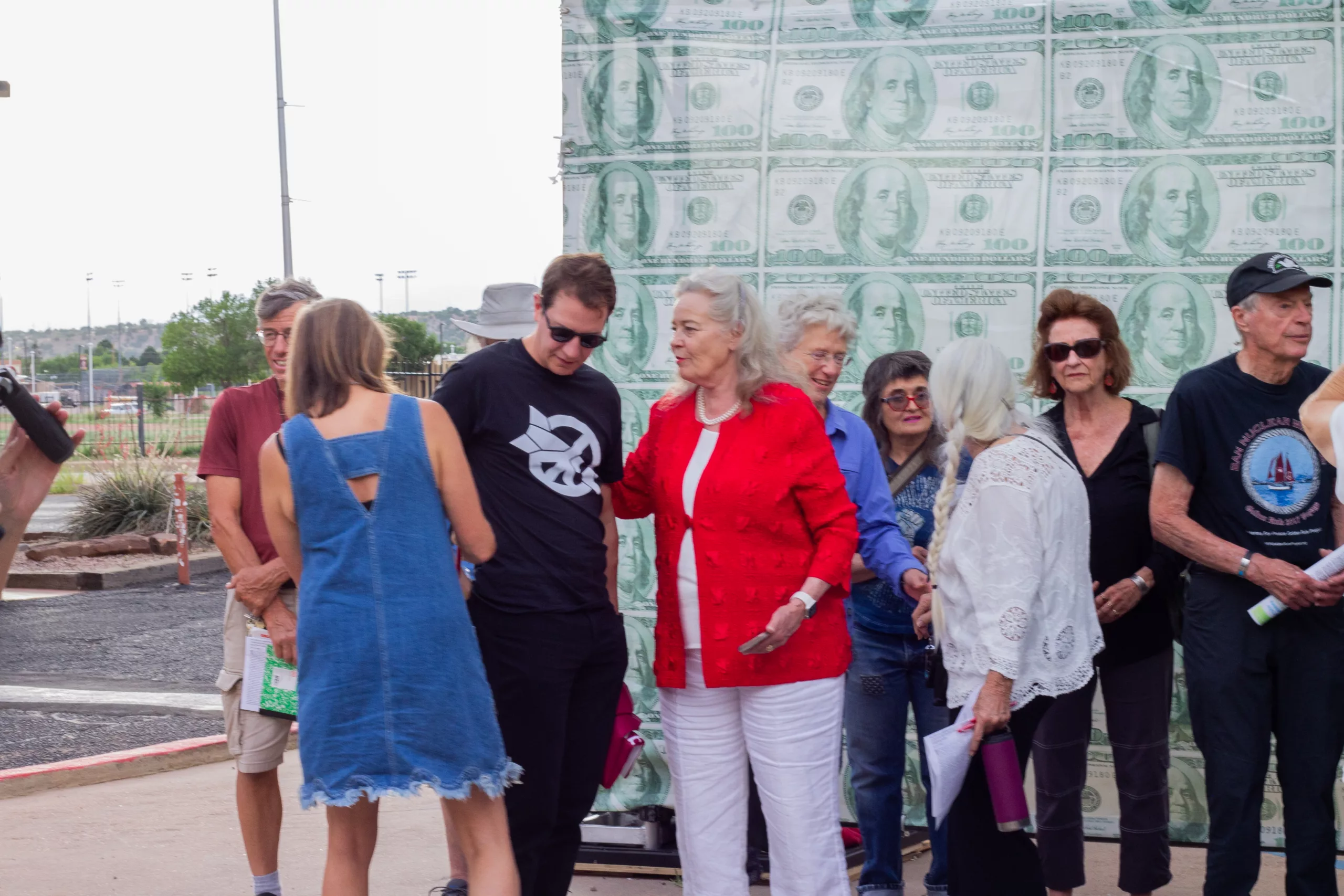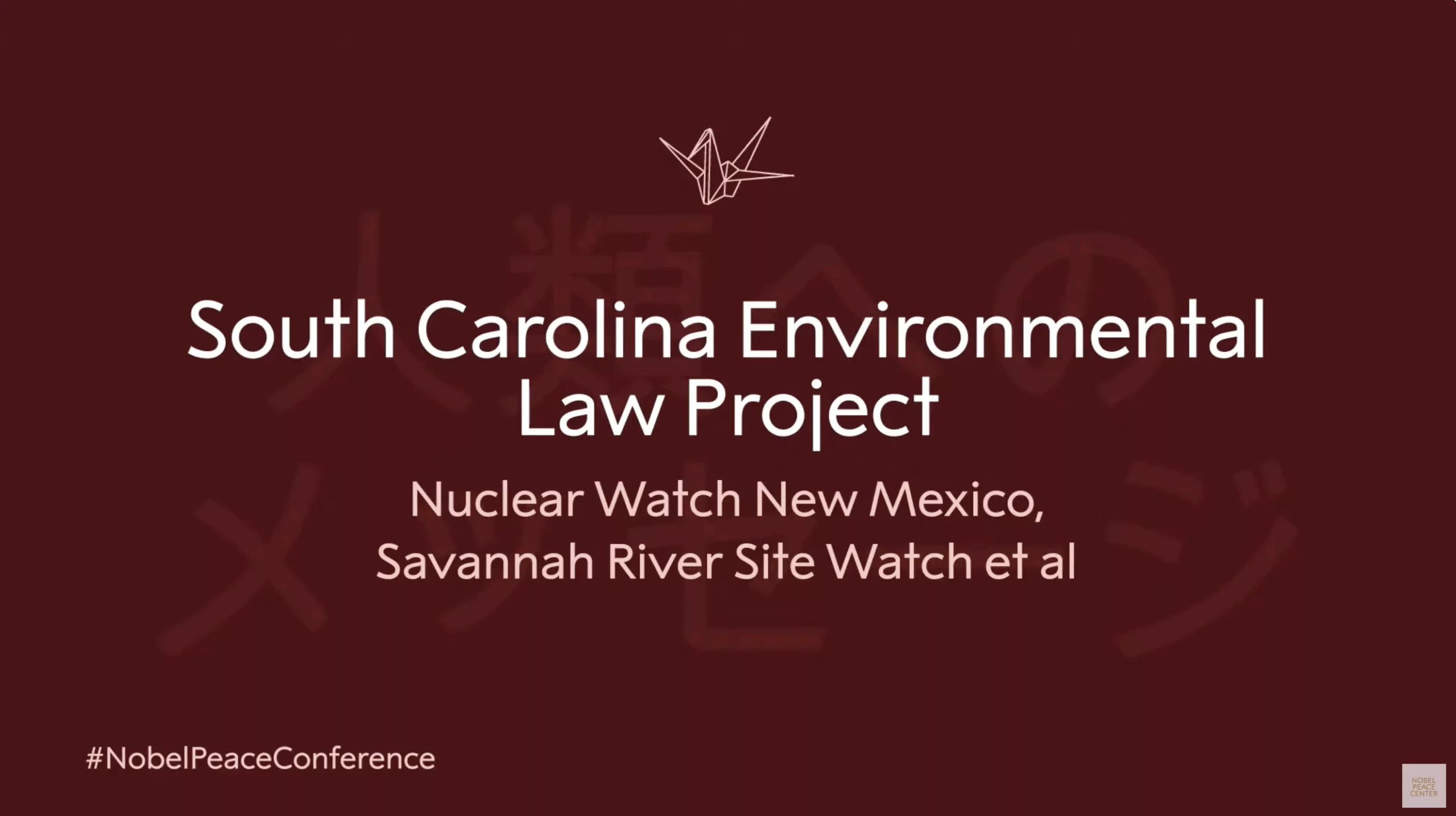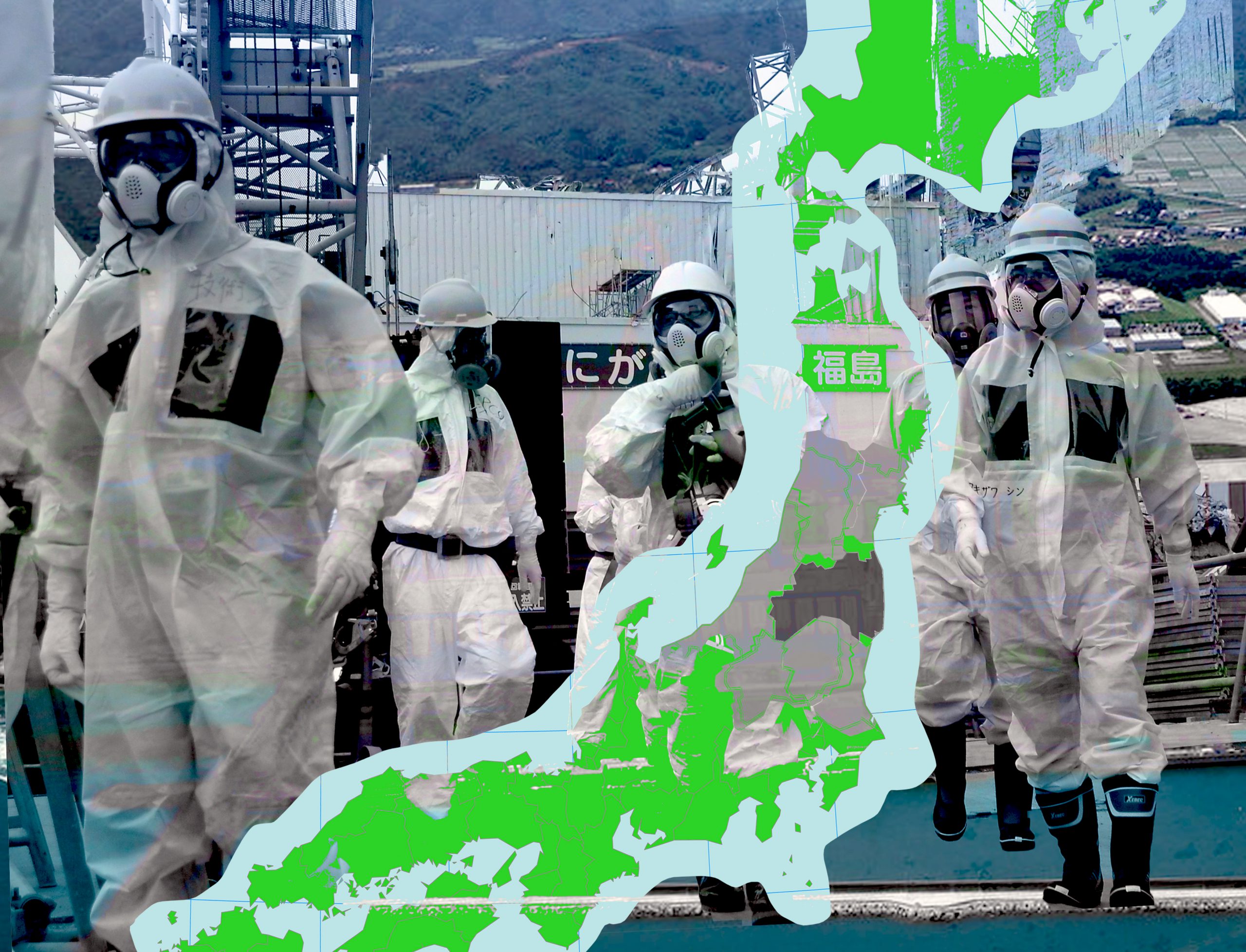VIEW THE RECORDING: Santa Fe Ecumenical Conversations Towards Nuclear Disarmament at Santa Maria de la Paz Catholic Community – Monday, October 27
Archbishop John C. Wester and NukeWatch New Mexico presented a special evening at Santa Maria de la Paz Catholic Community on Monday, October 27, from 6:00 to 8:00 p.m. MT. Following a presentation from NukeWatch executive director Jay Coghlan on U.S. nuclear weapons “modernization,” the Archbishop shared reflections from his pastoral letter, Living in the Light of Christ’s Peace, and speak about the importance of dialogue and hope in working toward nuclear disarmament.
View the recording at https://www.youtube.com/watch?v=9LFmQzMoJds&t=1s
Trump Orders Nuclear Weapons Testing for New Nuclear Arms Race
New Plutonium “Pit” Bomb Cores at Los Alamos Lab Could Make It Real
Just minutes before meeting with Chinese President Xi Jinping, Trump posted on his Truth Social media platform that “Because of other countries testing programs, I have instructed the Department of War to start testing our Nuclear Weapons on an equal basis. That process will begin immediately.” House Speaker Mike Johnson soon followed on CNN saying, “I think it is an obvious and logical thing to ensure that our weapons systems work.”
No other countries are currently testing nuclear weapons (the last was by North Korea in 2017). Further, any nuclear weapons tests by the U.S. would be performed by the Department of Energy (whose last test was in 1992), not the Department of War (until recently the Department of Defense). Trump was likely referring to Vladimir Putin’s recent claims of a new nuclear powered cruise missile and a tsunami-causing nuclear-armed torpedo that could threaten America’s coastal cities. In addition, China is dramatically expanding its own fleet of intercontinental ballistic missiles.
But central to all this is the U.S.’ own $2 trillion “modernization” program that will rebuild every nuclear warhead in the planned stockpile with new military capabilities and produce new-design nuclear weapons as well. This so-called modernization program will also build new nuclear weapons production facilities expected to be operational until ~2080, and buy new missiles, subs, and bombers from the usual rich defense contractors, all to keep nuclear weapons forever.
‘Nuclear weapons are blasphemous’: Archbishop Wester continues disarmament push with talk
This event was organized by the “Santa Fe Ecumenical Conversations Towards Nuclear Disarmament” group at the Santa Maria de la Paz parish near the Santa Fe Community College. They kindly invited NukeWatch to speak before Archbishop Wester for what turned out to be a wonderful event. The full recording can be viewed at https://www.youtube.com/@SMDLP/streams
By Cormac Dodd cdodd@sfnewmexican.com | October 28, 2025 santafenewmexican.com
Despite saying he has received a somewhat muted response from the local faithful, Santa Fe’s Catholic archbishop is still pushing nuclear disarmament as vital to humanity’s spiritual well-being and continued existence.
“I think nuclear weapons are blasphemous, because I think nuclear weapons are humanity’s attempt to build a Tower of Babel, an attempt to eat from the apple of the tree of the Garden of Eden, to become like God, to become gods,” Archbishop John C. Wester said in a roughly 30-minute address at Santa Maria de la Paz Catholic Church south of Santa Fe.
“In humility, we must avoid inventing anything that, in a matter of hours, can destroy what God has created,” the leader of the Archdiocese of Santa Fe continued. “The story of Adam and Eve is archetypal, I think: When human beings try to become as God, they lose the Garden of Eden and they must endure the cruel reality of paradise lost.”
The archbishop’s comments followed a journey he undertook to Japan on the 80th anniversary of the U.S. military’s decision to drop atomic bombs on Hiroshima and Nagasaki toward the end of World War II. He spoke in front of an audience of about 50 people — who gave Wester a standing ovation — at Monday’s event
In a Looming Nuclear Arms Race, Aging Los Alamos Faces a Major Test
The lab where Oppenheimer developed the atomic bomb is the linchpin in the United States’ effort to modernize its nuclear weapons. Yet the site has contended with contamination incidents, work disruptions and old infrastructure.
By Alicia Inez Guzmán | October 28, 2025 The New York Times nytimes.com
In a sprawling building atop a mesa in New Mexico, workers labor around the clock to fulfill a vital mission: producing America’s nuclear bomb cores.
The effort is uniquely challenging. Technicians at Los Alamos National Laboratory must handle hazardous plutonium to create the grapefruit-size cores, known as pits. They do so in a nearly 50-year-old building under renovation to address aging infrastructure and equipment breakdowns that have at times disrupted operations or spread radioactive contamination, The New York Times found.
Now, the laboratory is under increasing pressure to meet the federal government’s ambitions to upgrade the nation’s nuclear arsenal. The $1.7 trillion project includes everything from revitalizing missile silos burrowed deep in five states, to producing new warheads that contain the pits, to arming new land-based missiles, bomber jets and submarines.
But the overall modernization effort is years behind schedule, with costs ballooning by the billions, according to the Congressional Budget Office. In 2018, Congress charged Los Alamos with making an annual quota of 30 pits by 2026, but by last year it had produced just one approved for the nuclear stockpile. (Officials have not disclosed whether more have been made since then.)
*The featured image differs from the article photo due to usage rights.
Why Putin’s ‘invincible’ nuclear-powered missile is more likely to become a disastrous ‘flying Chernobyl’ for Russia
The US abandoned efforts to build nuclear-powered missile weapons during the 1950s arms race with the Soviet Union as a nuclear-powered missile would effectively be a huge radiation risk.
Jeffrey Lewis, a nuclear nonproliferation expert at Middlebury College, described it as a “tiny flying Chernobyl,” referencing the Soviet power plant that melted down and covered a 1,600-mile area with toxic radiation…While Lewis believes the Burevestnik is only capable of subsonic speed and easy to intercept, he warned that Russia’s ambition poses a return to the Cold War era.
“NATO aircraft could intercept it. The problem is that Burevestnik is yet another step in an arms race that offers no victory for either side,” he wrote on X.
By Ronny Reyes | October 28, 2025 nypost.com
Russian strongman Vladimir Putin’s latest threats that Moscow is preparing to deploy its new “invincible” nuclear-powered cruise missile has drawn a rebuke from President Trump and a reminder of America’s own nuclear might.
But experts say the Burevestnik missile could end up being more like a disastrous “flying Chernobyl” for Russia — and proves Putin is actually nervous about the possibility of the US giving Tomahawk cruise missiles to Ukraine.
George Barros, of the Washington-based Institute for the Study of War, described Putin’s ominous Sunday announcement as a form of fear mongering from a Kremlin afraid that the US could give Kyiv a much more conventional weapon — the tried and true Tomahawk.
Russia tested new nuclear-powered Burevestnik cruise missile
“For Trump, who has cast Russia as a “paper tiger” for failing to swiftly subdue Ukraine, the message is that Russia remains a global military competitor, especially on nuclear weapons, and that Moscow’s overtures on nuclear arms control should be acted on.”
By Guy Faulconbridge and Lidia Kelly Tim Balk | October 26, 2025 reuters.com
- Russia tests nuclear-capable Burevestnik missile
- Missile flew for 14,000 km, 15 hours
- Putin says it can pierce any missile defences
Trump Administration Providing Weapons Grade Plutonium to Sam Altman
“If there were adults in the room and I could trust the federal government to impose the right standards, it wouldn’t be such a great concern, but it just doesn’t seem feasible.”
By: Joe Wilkins | October 24, 2025 futurism.com
With the economy the way it is these days, it’s nice to have a little walking around money.
Donald Trump certainly thinks so. Since his return to the White House, the president has labeled 440 federal properties for possible sale, leased 13.1 million acres of public land for strip mining, and held a fire sale for satellites developed by NASA’s Jet Propulsion Lab.
In one of his wildest money moves to date, the Financial Times reports that Trump is now offering companies access to plutonium from America’s arsenal of cold war nuclear missiles.
On Tuesday, the US Department of Energy (DOE) launched an application for interested parties to apply for access to a maximum of 19 metric tonnes — a little under 42,000 pounds — of weapons-grade plutonium, which has long been a key resource undergirding the US nuclear arsenal.
One of the companies anticipated to receive shipments of the fissile isotope from the DOE is Oklo, a “nuclear startup” backed — and formerly chaired — by OpenAI CEO Sam Altman. Earlier in October, Oklo was one of four US companies chosen by the DOE to join a new pilot program meant to rush the testing and approval of experimental reactor designs.
As the FT reports, we won’t know for certain until December 31, when the DOE announces the companies selected to purchase the plutonium, but it’s likely Oklo will be among them. That’s stirring up plenty of anxiety throughout the scientific community, who say the relaxed approach to nuclear development is a major cause for alarm.
“If there were adults in the room and I could trust the federal government to impose the right standards, it wouldn’t be such a great concern, but it just doesn’t seem feasible,” Edwin Lyman, a physicist with the Union of Concerned Scientists told the FT.
U.S. Agency That Protects Nuclear Arsenal to Furlough Workers
Jay Coghlan, the executive director of Nuclear Watch New Mexico, a private group that monitors the agency, said it was unclear if the furloughs would have any immediate effect on nuclear safety. “As a baseline, the nuclear safety officers have always been understaffed. There is simply not enough federal oversight as is. And then you’re talking about furloughing more,” he added.
By Tim Balk | October 17, 2025 nytimes.com
![]() The National Nuclear Security Administration said 1,400 workers would be affected by Monday.
The National Nuclear Security Administration said 1,400 workers would be affected by Monday.
Nuclear weapons safety oversight in decline with Trump, Biden inaction
The lone independent federal agency responsible for ensuring safety at U.S. nuclear weapons sites — including Hanford in Washington state — will lose its ability to issue recommendations for safer work by January if the Trump administration doesn’t replenish its board, which this month dwindles to one member.
By Patrick Malone | October 15, 2025 seattletimes.com
The Defense Nuclear Facilities Safety Board ensures adequate public health and worker safety by scrutinizing hazardous work conducted by the U.S. Department of Energy and its contractors that produce and maintain the nuclear arsenal. If the Trump administration and Congress don’t move quickly to populate the board, it will be incapable of issuing formal safety recommendations to the Energy Department, according to a report last month from the Government Accountability Office, Congress’ investigative arm.
If the board is without a quorum of at least three members for a year, “the agency would essentially be able to offer only nonbinding advice to DOE,” according to the report.
“The whole idea of having the board in place is to provide the optics in addition to the substance,” Nathan Anderson, a Washington state-based director in the GAO’s natural resources division, told The Seattle Times.
The board does not have regulatory or enforcement authorities, but its advice carries significant weight and cannot be easily dismissed or disregarded, the GAO report states. The board’s recommendations to the U.S. secretary of energy are published for public comment, and the secretary must respond in writing. The board also reports each year to selected congressional committees on its recommendations to the Energy Department and any outstanding safety problems.
FULL ORIGINAL ARTICLE (SEATTLE TIMES)
YOU CAN HELP SAVE THE DNFSB TODAY:
Continue reading
New Article about “Participatory Democracy in Action” Describes WIPP Permit Negotiations
Thanks to our friends at Concerned Citizens for Nuclear Safety for this article:
In an essay for NYU’s Democracy Project, David F. Levi, a former federal judge and director emeritus of the Bolch Judicial Institute at Duke Law, reflected on the negotiations he facilitated in New Mexico about the renewal of the hazardous waste permit for the Waste Isolation Pilot Plant (WIPP), a deep geologic repository for plutonium-contaminated waste generated in the fabrication of nuclear weapons. Judge Levi’s essay is entitled “Participatory Democracy in Action.” He wrote:
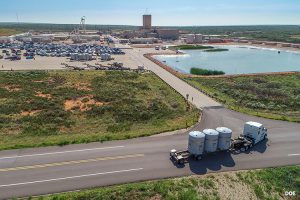 “A couple of years ago, I was asked to mediate a dispute between the U.S. Department of Energy (DOE) and the New Mexico Environment Department (NMED) concerning the renewal of a required state permit for DOE’s Waste Isolation Pilot Plant (WIPP), the nation’s only deep underground nuclear waste storage facility, located outside of Carlsbad, New Mexico. I thought I could help the two government entities but quickly came to realize that under the mediation procedures followed by New Mexico, the mediation would also involve citizen groups whose ultimate concurrence was essential to any complete resolution. This was entirely new to me.
“A couple of years ago, I was asked to mediate a dispute between the U.S. Department of Energy (DOE) and the New Mexico Environment Department (NMED) concerning the renewal of a required state permit for DOE’s Waste Isolation Pilot Plant (WIPP), the nation’s only deep underground nuclear waste storage facility, located outside of Carlsbad, New Mexico. I thought I could help the two government entities but quickly came to realize that under the mediation procedures followed by New Mexico, the mediation would also involve citizen groups whose ultimate concurrence was essential to any complete resolution. This was entirely new to me.
“In this case, there were seven such citizen groups entitled to participate and representing a variety of points of view. There was one group representing some of the government and business leaders of the town of Carlsbad who favored permit renewal on terms ensuring the continued long-term operation of WIPP. There were six groups expressing a variety of concerns about nuclear waste coming to New Mexico. They sought a more restrictive permit.
“To my astonishment, over the course of four full days, we worked through the multitude of issues and came to complete agreement. Something magical had happened. Thanks to the goodwill of the DOE and its contractor, the remarkable daily attendance and attentiveness of the NMED Secretary and the measured and well-informed way in which the various citizen groups made their points, we were able to find consensus and craft permit language that was acceptable to everyone.
“For me, as a former judge and mediator, the experience was thrilling. It was an experience of participatory democracy in action that made me proud of our fellow citizens and our government. Three aspects of the experience stand out. First, everyone in the room had taken responsibility for the way in which our nation’s only deep underground nuclear storage facility would be operated for the next 10 years. The citizen participants were not just making suggestions; they were assuming many of the attributes of decision makers. Second, all participants were advocating, compromising, and collaborating on behalf of what they saw as the public interest. These are the essential skills of democracy—the civic virtues so central to the Founders’ vision of what would make democracy work in America—and they require practice. Finally, over four days around a table, the citizens were able to take the measure of the DOE and NMED representatives. They came to realize, as I did, that these public servants, as well as the DOE contractor, were very well-informed, experienced, and intentioned. The government representatives had a similar experience of coming to appreciate the citizen questions and points of view. A government that relies on trust needs this kind of interaction to maintain that trust.
“It seems our democracy would be strengthened if we could extend the benefits of this kind of participatory structure to other areas of our legal and regulatory systems.”
“In Democracy in America, Alexis de Tocqueville made some of these points in reference to the jury trial in civil cases. He emphasized the importance of the civil jury trial as a free “public school” [https://contextus.org/Tocqueville,_Democracy_in_America_(1835),_Book_I,_Chapter_XVI_Causes_Mitigating_Tyranny_In_The_United_States_(Part_II).13?ven=Gutenberg&lang=en]  educating jurors in the democratic virtues and skills and teaching them to assume responsibility. In the same vein, every trial judge I know would attest to the importance of the jury experience for building confidence in the courts. After a trial, judges often hear words of gratitude from jurors who are deeply impressed by the legal process and are honored to have participated despite their initial dismay at being called to jury service. Sadly, the number of jury trials has diminished, particularly in federal court. Reversing that trend is a worthy goal, particularly for a branch of government that depends so heavily on public confidence.
educating jurors in the democratic virtues and skills and teaching them to assume responsibility. In the same vein, every trial judge I know would attest to the importance of the jury experience for building confidence in the courts. After a trial, judges often hear words of gratitude from jurors who are deeply impressed by the legal process and are honored to have participated despite their initial dismay at being called to jury service. Sadly, the number of jury trials has diminished, particularly in federal court. Reversing that trend is a worthy goal, particularly for a branch of government that depends so heavily on public confidence.
“As a final reflection: any persons involved as litigants will have an experience of the legal system. The experience can advance their sense of agency and participation, their ability to disagree civilly, and their trust in the courts. But how can these objectives be obtained when so many Americans cannot afford a lawyer? We can do so much better to provide understanding of and access to our justice system.”
The six New Mexico based non-governmental organizations were Citizens for Alternatives to Radioactive Dumping (CARD), Concerned Citizens for Nuclear Safety (CCNS), Conservation Voters New Mexico (CVNM), Nuclear Watch New Mexico, Southwest Alliance for a Safe Future (SAFE), and Southwest Research and Information Center (SRIC). The individual was Steve Zappe, a grandfather and former NMED WIPP Program Manager.
“A House of Dynamite” New Netflix Nuclear Catastrophe Film: Fiction, for Now
The reviews are rolling in for “A House of Dynamite,” which premiered in Europe earlier this month before coming to the U.S. on October 10th, with a full Netflix release scheduled for the 24th. Here’s the trailer, and see the schedule for Santa Fe theater showings here:
This Week! Santa Fe Theater Screenings for the Film “A House of Dynamite”
I attended one of these screenings last night, and I’ll let the professional critic reviews give the gist:
The Kathryn Bigelow thriller looks at what might happen if a ballistic missile were headed to the U.S. The director hopes the movie will start a conversation. New York Times: At Venice, ‘A House of Dynamite’ Is Scarier Than Most Horror Films
“The Netflix thriller captures from multiple perspectives the White House response to an unattributed missile launch headed for a major U.S. city in the harrowing 20 minutes until projected impact…”An unrelenting chokehold thriller so controlled, kinetic and unsettlingly immersive that you stagger out at the end of it wondering if the world will still be intact.” ‘A House of Dynamite’ Review: Idris Elba and Rebecca Ferguson in Kathryn Bigelow’s Precision-Tooled, Viscerally Unsettling Nail-Biter
“Told from the perspective of soldiers at a remote Alaskan missile base, staffers in the White House situation room, military officials at US Central Command (CENTCOM), and the president of the United States, the film weaves an overlapping timeline to show how the United States would respond to a missile attack…The film doesn’t want viewers to ask themselves how to thwart a nuclear attack on the United States. Rather, it wants the viewer to question the value of having nuclear weapons at all. ‘None of this makes sense,’ the President (Idris Elba) bemoans, ‘Making all these bombs and all these plans.'”
“A House of Dynamite is a terrifying examination of how terribly wrong things can go even with highly competent people in charge…But that’s also not necessarily the world we’re living in…The film shows why the worst can happen, even when competent, well-meaning people are trying to do the right thing.
But what if competence and decency are in short supply?” A House of Dynamite: Bigelow’s latest thriller shows why nuclear bombs are only part of the danger
This film left me reeling with tension and anxiety and exactly as the Times article titles it, is scarier than most horror films. Unlike ‘Oppenheimer,’ which largely glorified the invention of the atomic weapon, ‘A House of Dynamite’ makes it impossible to ignore the threat that nuclear weapons pose to our world. Working backwards from perspectives, and focused on how we can actually improve our odds of keeping this story a fictional one, here is what struck me most about this film:
-
-
Only one person decides what happens. But the real threat isn’t one reckless leader — it’s a reckless system. The final segment of the film features the “nuclear football” heavily, a briefcase containing launch procedures and options. In the United States, the president holds the sole and absolute authority to order the use of nuclear weapons. In the film, there are many voices in the President’s ear, but two primary perspectives quickly emerge after the defense fails and the ICBM remains inbound to its U.S. target: “One side advocates a retaliatory strike; the other, nothing. ‘It’s surrender or suicide,’ one adviser tells the President,” – thebulletin.org. The military aide carrying the nuclear football is tasked with providing the President the list of options if retaliation is chosen. An absolute must-read, Daniel Ellsberg’s book “The Doomsday Machine” breaks down many of the themes in the film with pure and terrifyingly honest account of Cold War-era nuclear strategy. In terms of launch authority, he describes how the inherent instability of the delegated command structure of the nuclear apparatus makes accidental or unwanted war an ever-present danger.
-
LANL tritium containers to head to Texas after last treatment
Four flanged tritium waste containers have been depressurized and transported to Los Alamos National Laboratory’s Weapons Engineering Tritium Facility, where they will be treated further before heading out-of-state for disposal.
By Alaina Mencinger amencinger@sfnewmexican.com | October 15, 2025 santafenewmexican.com
The containers’ final destination is Waste Control Specialists, a West Texas facility that handles the storage and disposal of radioactive waste.
The more than 1,300-acre facility in Andrews County is located on an approximately 14,000 acre property, which is sited on a thick clay formation which the company describes as “nearly impermeable.”
New documents have been added to the Los Alamos Legacy Cleanup Contract Electronic Public Reading Room.
All legacy cleanup documents required to be posted after April 30, 2018, are available on the site linked above.
For legacy cleanup documents that were posted prior to April 30, 2018, please visit the LANL electronic public reading room.
- Review, Notice of Completion of Off-Site Waste Shipments for Final Disposal, Activities 3.1.5, 3.1.8, and 3.3.4, Compliance Plan, Site Treatment Plan, Federal Facility Compliance Order Los Alamos National Laboratory [July 31, Aug. 21, 2025]
https://ext.em-la.doe.gov/GovFTPFiles/api/GetFiles/GetFile?fileName=EMID-703933_NMED_Review_STP_Shpmt_Jul_31_Aug_21_101525.pdf
Strong Political and Public Opposition Means Consolidated Interim Storage Facility (CISF) in NM “Impossible in the Near Future”
NEW UPDATE OCTOBER 10, 2025:
Holtec abandons plan to build New Mexico storage facility for spent nuclear fuel
This is excellent news. The Governor and state legislature (specifically Senator Jeff Steinborn and Representative McQueen) are to be commended for not allowing New Mexico to become the nation’s dumping ground for highly radioactive commercial spent fuel rods, especially when the Land of Enchantment has never had its own nuclear energy plant. Hard work from many New Mexicans made this happen.
So-called “interim” storage would never be interim when the federal government has failed for more than four decades to find a permanent repository for these lethal wastes. This also shows how hollow all the hype is about the claimed renaissance of nuclear power, when on the front end the industry can’t survive without taxpayer handouts, and on the back end can’t solve its radioactive waste problem.
Holtec’s quote that “New Mexico’s acquiescence is necessary” for interim storage to go forward is interesting, implying that we have to surrender as the nuclear colony that we are. Well, guess what, we didn’t surrender, and I predict you’ll see more of this. Moreover, whether you’re pro-nuclear or anti-nuclear, Holtec is an ethically questionable company, which is why the attorneys general of New Jersey and Massachusetts have sued it.
Adiós and good riddance, Holtec!
New York Times: Tax Break Scandal Leads to $5 Million Fine for N.J. Energy Company
SEE MORE:
Nuclear Weapons Issues & The Accelerating Arms Race: September 2025
Nuclear Weapons Update:
Putin has offered Trump a one-year extension of the numerical cap on strategic nuclear weapons in the new Strategic Arms Reduction Treaty which is 1,550 warheads (however, B52s are counted as one warhead while they can carry a dozen). New START expires in February 2026, which will be the first time the world will be without any nuclear arms control treaties since the mid-1970s. Trump has said it sounded like a good idea.
Note: New START ratification in 2010 provided the opportunity for Republicans in the Senate to attach the condition of $88 billion for nuclear weapons “modernization” that has since metastasized to ~$2 trillion. Nuclear disarmament must be prioritized as the ultimate goal over simply continued arms control.
A mere extension of the numerical cap would not involve Congressional ratification. The extension of New START’s numerical cap is in part to allow for a year in which to begin negotiations for a treaty replacement.
Plutonium Pit Production:
A draft plutonium pit production programmatic environmental impact statement is expected to be released next year in early 2026.
Accelerating Arms Race:
Is North Korea set to become world’s ‘fourth ICBM power’ after missile breakthrough? | Park Chan-kyong | South China Morning Post | September 11, 2025
A new era in North Korea’s missile programme may be dawning, as analysts warn of an imminent test launch of an intercontinental ballistic missile capable of carrying multiple warheads to the US mainland. Fresh from his appearance at China’s Victory Day parade in Beijing last week, North Korean leader Kim Jong-un personally oversaw the trial of a lighter, more robust solid-fuel ICBM engine, state media reported on Tuesday, touting the achievement as a “strategic” breakthrough.
Saudi Arabia signs a mutual defense pact with nuclear-armed Pakistan after Israel’s attack on Qatar | MUNIR AHMED & JON GAMBRELL | AP NEWS | September 18, 2025
DUBAI, United Arab Emirates (AP) — Pakistan’s defense minister says his nation’s nuclear program “will be made available” to Saudi Arabia if needed under the countries’ new defense pact, marking the first specific acknowledgment that Islamabad had put the kingdom under its nuclear umbrella.
Defense Minister Khawaja Mohammad Asif’s comments underline the importance of the pact struck this week between Pakistan and Saudi Arabia, which have had military ties for decades.
The move is seen by analysts as a signal to Israel, long believed to be the Middle East’s only nuclear-armed nation. It comes after Israel’s attack targeting Hamas leaders in Qatar last week killed six people and sparked new concerns among Gulf Arab nations about their safety as the Israel-Hamas war devastated the Gaza Strip and set the region on edge.
Russia suspected of helping North Korea build nuclear submarines, Seoul investigating | Park Chan-kyong | South China Morning Post | September 18, 2025
South Korea is investigating reports that Russia has supplied North Korea with nuclear submarine reactor modules, a move analysts see as highly plausible and one that could mark a breakthrough in Pyongyang’s decades-long push for a nuclear-powered navy… At the 8th Party Congress in January 2021, North Korea declared five core defence goals, including the development of nuclear-powered submarines and submarine-launched strategic nuclear weapons.
China Hardens Military Stance Against U.S. With Nuclear Weapons and Tough Talk | Brian Spegele | The Wall Street Journal| September 18, 2025
China played down its rapidly rising military might for years. In the past few weeks, Beijing has broadcast a steady drumbeat of firepower displays and muscular rhetoric, carrying an unmistakable warning for the U.S… Part of China’s confidence stems from the rapid growth of its firepower. The Pentagon estimates that China’s stockpile of nuclear warheads has more than doubled since 2020, alongside a growing array of options to launch those weapons, from mobile ground-launch systems to increasingly stealthy submarines.
Holtec Pulls Out of New Mexico Spent Nuclear Fuel Interim Storage Project
Holtec International has confirmed it is canceling plans to build a consolidated interim storage facility for spent nuclear fuel in southeastern New Mexico.
By Radwaste Solutions | October 9, 2025 ans.org
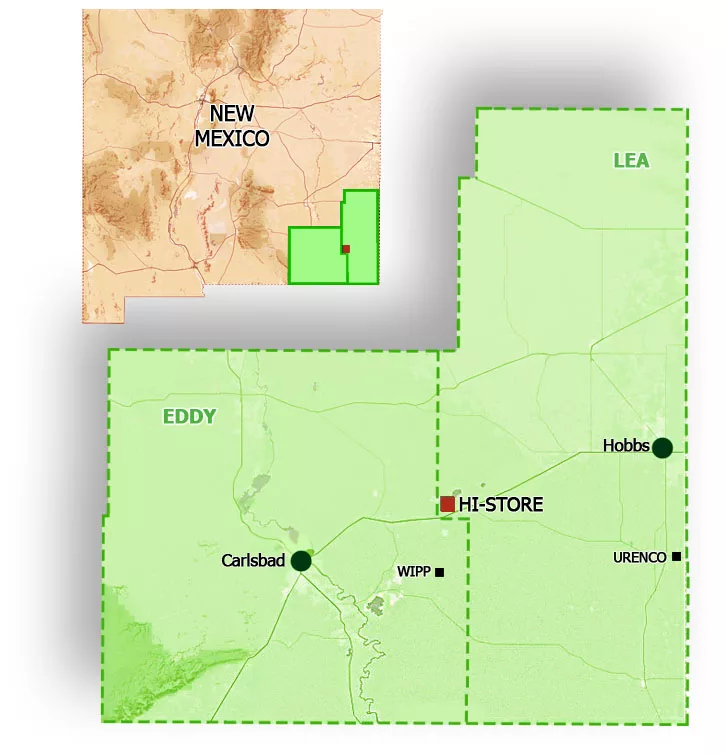
Named the HI-STORE CISF, the facility would have stored up to 10,000 canisters of commercial SNF on land owned by the Eddy-Lea Energy Alliance (ELEA) near the towns of Carlsbad and Hobbs.
“After discussions with our longtime partner in the HI-STORE project, the Eddy-Lea Energy Alliance, and due to the untenable path forward for used fuel storage in New Mexico, we mutually agreed upon canceling the agreement. This allows for ELEA to work to redevelop the property in a manner that fits their needs and allows Holtec to work with other states who are amenable to used fuel storage based on the recent DOE work on public education and outreach,” Holtec said in a statement (emphasis added).
Following the U.S. Supreme Court’s June ruling in NRC v. Texas, which found that petitioners did not have standing to challenge the Nuclear Regulatory Commission’s licensing of Interim Storage Partners’ CISF in Texas, Holtec said it expected to have its HI-STORE CISF license reinstated, allowing the company to move forward with the project. Holtec and ISP’s NRC licenses were vacated by the 5th Circuit Court of Appeals in a 2023 ruling.
Despite the court’s decision, New Mexico Gov. Michelle Lujan Grisham said she remained committed to preventing the HI-STORE CISF from being built. In 2023, New Mexico passed a bill barring the storage and disposal of high-level radioactive waste in New Mexico without the state’s explicit consent.
The AI Doomsday Machine Is Closer to Reality Than You Think
“Most troubling to experts on AI and nuclear weapons is that it’s getting harder and harder to keep decisions about targeting and escalation for nuclear weapons separate from decisions about conventional weapons.”
“There is no standing guidance, as far as we can tell, inside the Pentagon on whether and how AI should or should not be integrated into nuclear command and control and communications,” says Jon Wolfsthal, director of global risk at the Federation of American Scientists.
By Michael Hirsh | September 2, 2025 politico.com
Jacquelyn Schneider saw a disturbing pattern, and she didn’t know what to make of it.
Last year Schneider, director of the Hoover Wargaming and Crisis Simulation Initiative at Stanford University, began experimenting with war games that gave the latest generation of artificial intelligence the role of strategic decision-makers. In the games, five off-the-shelf large language models or LLMs — OpenAI’s GPT-3.5, GPT-4, and GPT-4-Base; Anthropic’s Claude 2; and Meta’s Llama-2 Chat — were confronted with fictional crisis situations that resembled Russia’s invasion of Ukraine or China’s threat to Taiwan.
Director Kathryn Bigelow is Sounding the Nuclear Alarm – Washington Post New Review
“A House of Dynamite” asks: How would the White House respond in the face of a nuclear attack?
By Max Boot | October 2, 2025 washingtonpost.com
VIEW MORE: “A House Of Dynamite” Q&A w/ Director Kathryn Bigelow, Tracy Letts, Jared Harris, And More At New York Film Fest —
80th Commemorations of Ban the Bomb – Trinity, Hiroshima & Nagasaki Remembrances in New Mexico
Exchange Monitor: DNFSB makes agency fixes, but needs members, GAO finds
The Defense Nuclear Facilities Safety Board (DNFSB) has tackled all but a few third-party recommendations to improve its culture over the past decade but suffers from a depleted board, according to a new report.
By ExchangeMonitor | September 5, 2025 santafenewmexican.com
Progress is tough with the five-person board probably…
China Hardens Military Stance Against U.S. With Nuclear Weapons and Tough Talk
Xi positions Beijing as powerful center of new global order as security forum convenes in capital
By Brian Spegele | September 18, 2025 wsj.com
BEIJING—China played down its rapidly rising military might for years. In the past few weeks, Beijing has broadcast a steady drumbeat of firepower displays and muscular rhetoric, carrying an unmistakable warning for the U.S….
Saudi Arabia signs a mutual defense pact with nuclear-armed Pakistan after Israel’s attack on Qatar
While not specifically discussing the bomb, the agreement states “any aggression against either country shall be considered an aggression against both,” according to statements issued by both Pakistan’s Foreign Affairs Ministry and the state-run Saudi Press Agency.
By MUNIR AHMED and JON GAMBRELL | September 18, 2025 apnews.com
ISLAMABAD (AP) — Saudi Arabia and nuclear-armed Pakistan have signed a mutual defense pact that defines any attack on either nation as an attack on both — a key accord in the wake of Israel’s strike on Qatar last week.
The kingdom has long had close economic, religious and security ties to Pakistan, including reportedly providing funding for Islamabad’s nuclear weapons program as it developed. Analysts — and Pakistani diplomats in at least one case — have suggested over the years that Saudi Arabia could be included under Islamabad’s nuclear umbrella, particularly as tensions have risen over Iran’s atomic program.
COMMUNITIES FOR CLEAN WATER: LANL Radioactive Tritium Venting Fails to Provide Transparency, Assurance, and Respect for Local Communities
FOR IMMEDIATE RELEASE: September 18, 2025
Santa Fe, NM — As NNSA and LANL continue operations to depressurize Flanged Tritium Waste Containers, Communities for Clean Water (CCW) calls out federal agencies for issuing vague assurances instead of transparent, verifiable data — and for dismissing community concerns with contradictory and incomplete statements that disregard what independent experts have found, the Department of Energy’s (DOE) own legal obligations, and the New Mexico Environment Department’s (NMED) acknowledgment that LANL has a long record of compliance failures.
“How can our communities be expected to trust LANL when they won’t give us access to the raw, real-time monitoring data – independently verified by the EPA,” asks Joni Arends with Concerned Citizens for Nuclear Safety. “Without this transparency, LANL is continuing a legacy of empty assurances, not accountability.”
Key Concerns:
-
Lack of real-time transparency – Since Friday (Sept. 12), the public has been forced to rely on NMED’s Facebook page for piecemeal updates. While LANL’s website provides very brief daily summaries, no near-real-time monitoring dashboard from DOE, NNSA, or LANL has been made available.
-
Vague assurances, not real information – NNSA’s updates claim “no tritium was released” while simultaneously telling the public to expect “very low levels of tritium” for subsequent venting. Without numbers, monitoring data, or detection thresholds, these phrases do not provide reassurance.
-
Weather risks – LANL has not disclosed thresholds for wind, rain, or humidity that would postpone venting. Communities watch weather shifts in real time but are left in the dark about how safety decisions are being made.
-
Dismissal of public health concerns – When asked for plain-language guidance that NMED stated LANL would provide, LANL responded only with “no offsite impact anticipated.” This is not meaningful and reassuring guidance, it’s a blanket dismissal that disregards independent expert findings and fails to meet DOE’s obligations to protect vulnerable populations.
-
Ignoring daily lifeways – Avoiding Pueblo Feast Days is not enough. This is harvest season, when outdoor cultural events, youth programs, and farming are in full swing. LANL’s scheduling continues to disregard these realities.
Unanswered Questions
Independent experts and community advocates have raised critical unanswered questions:
-
Unclear “depressurization” – LANL said “no internal pressure was found” in a container, but also claimed it was “depressurized.” If no pressure existed, what was released?
-
Unanswered helium questions – NMED stated helium was released, but LANL has not explained its origin. Was it introduced at sealing of the outer container, or a decay product of tritium?
-
Monitoring limits undisclosed – LANL has not disclosed the detection limits of its monitoring equipment. Readings “indistinguishable from zero” could still mask releases.
DOE NNSA Gives Misleading Statements on Native America Calling
On a recent Native America Calling program, DOE NNSA’s Los Alamos Field Office Deputy Director Pat Moss compared LANL venting to global natural tritium stocks. Independent expert Dr. Arjun Makhijani pointed out this comparison as misleading: “The problem is not global background, but local contamination. If venting occurs in rain and calm winds, local rainfall could exceed U.S. drinking water standards by hundreds to thousands of times.”
In their most recent public meeting, LANL admitted that infants could receive three times the radiation dose as adults. During the interview, Dr. Makhijani pressed this point – if adults are modeled at 6 mrem, that means infants could be at 18 mrem, nearly double the EPA’s 10 mrem compliance limit. Instead of addressing this directly, Mr. Moss provided a stock line, “We will be compliant with the regulatorily imposed release threshold and will be doing the calculations per the regulation.”
That is exactly the problem – hiding behind regulatory caps while ignoring clear evidence that infants, our most vulnerable, face exposures above legal limits.
DOE NNSA also pointed to the Defense Nuclear Facilities Safety Board (DNFSB) – an independent federal oversight body created by Congress – as if it had declared the tritium venting operation as “fully protective of the public”. That is misleading. First, the DNFSB has been operating without a quorum for months, limiting its ability to issue independent recommendations. Second, what the Board staff said in its July 2025 presentation was that the overall nuclear safety risk to the public is low if DOE’s proposed controls are followed. The DNFSB has also flagged ongoing safety concerns at LANL including deficiencies in Area G’s safety analysis and risk to workers.
First of four containers of tritium waste at LANL has been vented
The first of four flanged tritium waste containers awaiting removal from Los Alamos National Laboratory has been vented, the New Mexico Environment Department announced Tuesday afternoon.
By Alaina Mencinger amencinger@sfnewmexican.com | September 16, 2025 santafenewmexican.com
The container can now be moved for treatment at LANL and then, eventually, to an off-site disposal area.
No internal pressure was found in the first container, according to the National Nuclear Security Administration, suggesting the inner containers in the flanged tritium waste container hadn’t leaked. Air monitoring did not show an increase of tritium beyond background levels, the federal agency wrote.
No tritium emissions were released, the Environment Department wrote in its Tuesday post on X, formerly Twitter. Both the state agency and the U.S. Environmental Protection Agency are monitoring the process.
The depressurization of the containers is set to continue at 7 a.m. Wednesday, although the NNSA noted the schedule is subject to change due to weather. The four containers will be vented one at a time over an estimated two-week period.
*The featured image differs from the article photo due to usage rights.
New Mexicans Can Save the DNFSB; Contact Our Senators Today
From our friends at Concerned Citizens for Nuclear Safety:
The independent Defense Nuclear Facilities Safety Board has been dwindling from a five-member board to one member and may disappear if we, the People, do not raise our voices to support its essential nuclear safety work. The Safety Board needs at least two new members. And that needs to get done by Saturday, October 18th. https://www.dnfsb.gov/about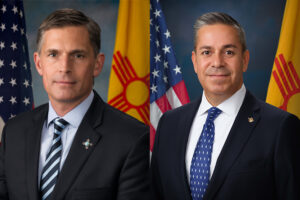
New Mexico U.S. Senators Heinrich and Lujan have key roles to play to ensure the Safety Board’s work continues unimpeded. https://www.heinrich.senate.gov/ and https://www.lujan.senate.gov/ Our voices of support are essential to ensure communities continue to receive the essential services of the Safety Board and its staff.
Right now members of the Safety Board’s staff are monitoring the venting of radioactive tritium from Area G at Los Alamos National Laboratory (LANL). Their expertise in the field of nuclear safety and their demonstrated competence and knowledge relevant to their independent investigative and oversight functions are an essential part of the process. They will be part of the follow-up once the venting of the four flanged tritium waste containers is completed. https://tewawomenunited.org/?s=tritium, https://www.ccwnewmexico.org/tritium, https://nuclearactive.org/
Not only does the Safety Board have staff at LANL, but also at Sandia National Laboratories in Albuquerque and at the Waste Isolation Pilot Plant, the burial site for plutonium contaminated nuclear weapons waste, near Carlsbad. https://ananuclear.org/facilities/
Russia suspected of helping North Korea build nuclear submarines, Seoul investigating
Analysts said such a technology transfer was plausible given Pyongyang’s support for Russia’s ongoing war in Ukraine
By Park Chan-kyong | September 18, 2025 scmp.com
South Korea is investigating reports that Russia has supplied North Korea with nuclear submarine reactor modules, a move analysts see as highly plausible and one that could mark a breakthrough in Pyongyang’s decades-long push for a nuclear powered navy…
Holy See tells nations at UN to end threat of nuclear weapons, even as deterrence
Amid a global arms race, ending the threat of nuclear war — and even the testing of nuclear weapons — is imperative, said the Holy See’s diplomat to the United Nations.
By Gina Christian, OSV News | September 8, 2025 catholicreview.org
Archbishop Gabriele G. Caccia, the Holy See’s U.N. permanent observer, shared his thoughts in a statement he delivered Sept. 4 at U.N. headquarters in New York, during the General Assembly High-level Plenary Meeting to Commemorate and Promote the International Day Against Nuclear Tests, observed that same day.
“The pursuit of a world free of nuclear weapons is not only a matter of strategic and vital necessity, but also a profound moral responsibility,” Archbishop Caccia in his remarks.
He pointed to the introduction of nuclear weapons — first detonated by the U.S. in 1945 over the Japanese cities of Hiroshima and Nagasaki, killing an estimated 110,000 to 210,000 people, during World War II — as unveiling to the world “an unprecedented destructive force.”
Historic peace vigil partially dismantled after Trump orders: ‘Take it down’
Law enforcement officials on Sunday removed parts of the White House Peace Vigil, which has sat just outside the White House for decades.
By Marissa J. Lang, The Washington Post | September 8, 2025 washingtonpost.com
But over the past week, it faced a new threat as Trump turned his attention to the vigil and federal officers picked apart the structure that shields protesters and their signs from the elements. The vigil is maintained by a rotating cast of volunteers who keep the protest going 24 hours a day, seven days a week.
On Friday, Brian Glenn, a correspondent for the conservative network Real America’s Voice, told the president during a gathering with reporters that there was “a blue tent” in front of the White House that was “an eyesore.” Trump initially said he was unaware of it, but he then quickly ordered its removal.
Photo by Sig. Chiocciola, Creative Commons: The White House Peace Vigil on March 30, 2025 staffed by volunteers, Philipos Melaku-Bello (left) and Joe Brown (right).
For 80 years, nuclear weapons have been the unused threat
Amid a global arms race, ending the threat of nuclear war — and even the testing of nuclear weapons — is imperative, said the Holy See’s diplomat to the United Nations.
By Matt Kelly, mkelly@virginia.edu, September 3, 2025 news.virginia.edu
In the 80 years since World War II, which ended with the use of two atomic bombs, the world has maintained a tenuous relationship with nuclear weapons.
Philip Potter, professor of public policy at the University of Virginia’s Frank Batten School of Leadership and Public Policy and director of the National Security Data and Policy Institute, said he worries about the current delicate nuclear balance.
“Eighty years of non-use is the product of both good diplomacy and a recognition of the potential consequences,” Potter said. “The fearsome power of nuclear weapons causes countries pause before they use them, but a great deal of work has also gone into nonproliferation and the management of crises to keep them away from the nuclear brink. In some ways the dynamics of the Cold War made managing the potential for nuclear confrontation easier.”
It’s a very different strategic scenario now, where there are nine nuclear powers and less capacity to manage them.
A House of Dynamite review – Kathryn Bigelow’s nuclear endgame thriller is a terrifying, white-knuckle comeback
★★★★★: Amid a global arms race, ending the threat of nuclear war — and even the testing of nuclear weapons — is imperative, said the Holy See’s diplomat to the United Nations.
By Peter Bradshaw, The Guardian | September 2, 2025 theguardian.com
Kathryn Bigelow has reopened the subject that we all tacitly agree not to discuss or imagine, in the movies or anywhere else: the subject of an actual nuclear strike. It’s the subject which tests narrative forms and thinkability levels.
Maybe this is why we prefer to see it as something for absurdism and satire – a way of not staring into the sun – to remember Kubrick’s (brilliant) black comedy Dr Strangelove, with no fighting in the war room etc, rather than Lumet’s deadly serious Fail Safe.
NEW UPDATED INFORMATION: MUST READ!!! PROVIDED BY: THE TULAROSA BASIN DOWNWINDERS CONSORTIUM — WHAT TO KNOW ABOUT THE COMPENSATION AVAILABLE THROUGH THE RECA PROGRAM
 SEEKING JUSTICE FOR THE UNKNOWING, UNWILLING, AND UNCOMPENSATED INNOCENT VICTIMS OF THE JULY 16, 1945 TRINITY BOMB
SEEKING JUSTICE FOR THE UNKNOWING, UNWILLING, AND UNCOMPENSATED INNOCENT VICTIMS OF THE JULY 16, 1945 TRINITY BOMB
A Message From Tina
The DOJ is now accepting claims and has provided guidance on the claims process. They will only accept mail in claims at this time. They have indicated that an electronic process will be implemented by the end of the year. For more information you can go to the DOJ website at: https://www.justice.gov/civil/reca
Please be careful when supplying documentation via the regular mail. If you decide to file this way you may want to send the documents via certified mail. Once the electronic process begins it will be easier to assure that your documents are safe and being handled properly with little to no risk.
There are organizations/attorneys who are soliciting people to file claims with them. They use all sorts of tactics to get people to believe their services are necessary and often guarantee results. Please be aware that if an entity files a RECA claim on your behalf they will charge a fee. They receive the check, deduct their fee, and then pay you.
There will be Radiation Exposure Screening and Education Program (RESEP) clinics in our State that will assist people with claims. The claims process is not necessarily difficult and we’ll be training people to assist with the application process when needed. We’ll also be looking to government agencies to cooperate in locating necessary documentation for the application process. PLEASE DO NOT TURN OVER YOUR RECORDS TO ANYONE THAT YOU ARE NOT SURE ABOUT. You can remain updated about the application process, the training we’re going to organize or other questions you might have by going to our website at: www.trinitydownwinders.com
What does the expansion of RECA do?
The Radiation Exposure Compensation Act program has been re-authorized and extended through Dec 31, 2028 but the application deadline is Dec 31, 2027.
Downwinders who lived in New Mexico for one year from 1944 through Nov. 1962 will be eligible and family members can apply on behalf of a deceased loved one.
There are 19 cancers that are covered by the expansion.
The cancers covered are:
Leukemia (except chronic lymphocytic Leukemia); Lymphoma (other than Hodgkins); Primary cancers of the Thyroid, Breast, Esophagus, Stomach, Pharynx, Small Intestine, Pancreas, Bile Duct, Gall Bladder, Salivary Gland, Urinary, Bladder, Brain, Colon, Ovary, Liver (unless cirrhosis/Hepatitis B present), and Lung.
Compensation for downwinders will be increased to $100,000 and Downwind coverage is expanded to cover the entire state of New Mexico
Coverage for uranium miners and workers would be expanded:
To workers through Dec 31, 1990
To core drillers and remediation workers
To cover additional kidney disease for uranium miners
To allow for combined work histories
What does this mean?
This is the biggest expansion of RECA in the history of the program and it wouldn’t have happened without the tireless advocacy of Senator Lujan, Representative Leger Fernandez, Senator Heinrich, Representative Stansbury and Representative Vasquez.
While it is a significant win, it still leaves out many impacted communities, including the parts of Nevada and Arizona not previously covered, along with Montana, Colorado, and Guam.
The 2-year extension will likely not be adequate time to get all the people in New Mexico who qualify enrolled and this bill does not have health care benefits for Downwinders. We will continue to fight for a longer extension and the addition of healthcare benefits. This is an important first step because it reinstates the program keeping it operational so people can continue to apply for benefits and get the help they need, and it shows that expansion is possible and provides an opportunity to address concerns raised about the cost of expansion.
We are grateful for the win and consider this a big step in the right direction. We look forward to the day that claims are successfully filed and the people of New Mexico begin to see the benefit of the expansion of RECA. Stay tuned for updates and many thanks to all of you who have stood together with us in this fight!Continue reading
Threads cast and crew suffered ‘trauma’ after film
The creators of a documentary about the making of nuclear apocalypse film Threads say many of the cast and crew had “suffered with the trauma of being involved”.
By Chloe Aslett, BBC News | August 29, 2025 bbc.com
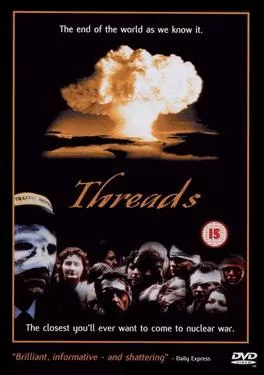
Threads, which tracks the aftermath of a nuclear attack on Sheffield, was first screened on the BBC on 23 September 1984 and fast became a cult classic.
Now filmmakers Craig Ian Mann and Rob Nevitt have spoken to more than 50 people involved in the making of the film for their documentary Survivors: The Spectre of Threads.
Mr Mann said: “[Threads] is a film that more than any I can think of everybody who worked on it it has impacted their lives in some way or another. Sometimes very positively and sometimes somewhat negatively.”
“There are people who have suffered the trauma of having been in and seen Threads,” he told BBC Radio Sheffield.
“There’s one participant in the documentary who has become a Doomsday prepper.
“He lives in America and has a bunker and canned food and weapons and he is prepared for the end of the world at any moment and that’s because he was in and saw Threads.”
Trump wants to stop nuclear proliferation. STRATCOM could play a major role.
Henry Sokolski, executive director of the Nonproliferation Policy Education Center, argues that the US needs to carry a new “big stick.”
By Henry Sokolski, Breaking Defense | August 29, 2025 breakingdefense.com

Last Monday, President Donald Trump pronounced, “We can’t let nuclear weapons proliferate.” Two days later, Secretary of State Rubio met with International Atomic Energy Agency (IAEA) Director General Rafael Mariano Grossi and recommitted the United States to preventing the proliferation of nuclear weapons.
After America’s bombing of Iran’s suspect nuclear sites, there’s cause to take these commitments seriously, but only if it’s more than a one off.
Emphasizing consistency is essential. Historically, America has backed nonproliferation in fits and starts. Under Presidents Gerald Ford and Jimmy Carter, the United States opposed the recycling of plutonium for commercial use because it was too close to bombmaking. It blocked reprocessing activities in South Korea, Taiwan, and Brazil.
Full Event Recording: Press Conference & Commemoration – Hiroshima Atomic Bombing 80th Anniversary Event (August 6, 2025)
DOE and LANL Silence Public and Tribal Community Member Voices While Pushing Radioactive Tritium Venting
For Immediate Release: August 22, 2025
Contact: Kalyn Mae Finnell, Coordinator, Communities for Clean Water
Los Alamos, NM — This week’s so-called “public meeting” regarding Los Alamos National Laboratory’s (LANL) proposal to vent radioactive tritium emphasized the persistence of the Department of Energy (DOE) National Nuclear Security Administration (NNSA) and LANL to disregard communities concerns while prioritizing nuclear weapons projects.
In-person attendees were allotted three minutes to make statements about their concerns. Over 100 online participants—including many Pueblo community members who could not attend the meeting in Los Alamos in-person due to health, distance, or work commitments—were surprised to find that they were not permitted to provide verbal comments and restricted to submitting only one emailed question. DOE/NNSA and LANL gave no prior notice of this change. “This is not meaningful participation. It is exclusion,” said Marissa Naranjo with Honor Our Pueblo Existence.
The stakes are at an all time high. Tritium — produced in the development of nuclear weapons as triated water — is a radioactive isotope of hydrogen that travels quickly through air, water, soil, and food. When exposed to the human body, it can cause cancer, genetic damage, cross the placental barrier, and cause health impacts across generations. DOE/NNSA insists venting is the sole safe option moving forward—however, their own “independent” technical review revealed significant issues with this assertion. The review acknowledged significant deficiencies: the absence of real-time monitoring, a lack of container-specific risk analysis, and insufficient examination of safer alternatives such as filtration or storage until decay occurs. Community members are also asking: How can a review be independent when DOE managed the process, designated the reviewer, and defined the scope? This does not represent independence—it signifies a conflict of interest.
“This is the same broken pattern we’ve seen for decades,” said Joni Arends with Concerned Citizens for Nuclear Safety. “LANL creates the danger, then tells us radioactive releases are our only option. They force the public and Pueblo communities into what NMED itself has called ‘untenable situations.'”
Local community leaders also noted that DOE has consistently overlooked reports by Tewa Women United, Communities for Clean Water, and scientific experts regarding the risks associated with tritium. These technical reports documented exposure pathways unique to Pueblo communities, including impacts on women, children, and traditional farming lifeways. By sidelining this research, DOE has once again dismissed Indigenous voices and lived experiences—further diminishing trust and perpetuating environmental racism.
“If our gathering here today is to mean anything, it must mean that in fidelity to all those whose lives were destroyed or savagely damaged on August 6, 80 years ago, we refuse to live in such a world of nuclear proliferation and risk-taking. We will resist, we will organize, we will pray, we will not cease, until the world’s nuclear arsenals have been destroyed.”
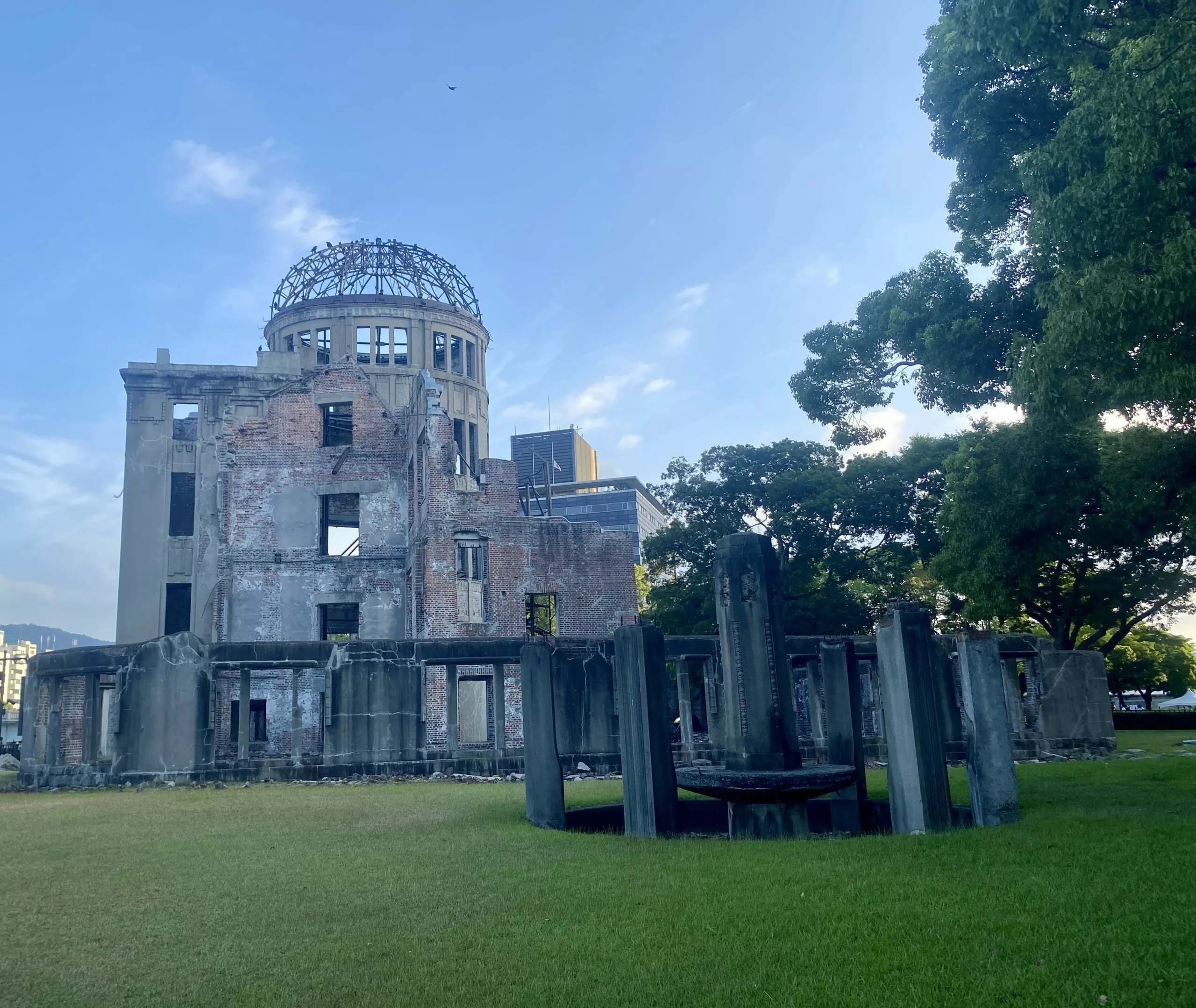 — Cardinal Bob McElroy of Washington, DC, August 5, 2025, at the World Peace Memorial Cathedral in Hiroshima, Japan.
— Cardinal Bob McElroy of Washington, DC, August 5, 2025, at the World Peace Memorial Cathedral in Hiroshima, Japan.
Nuclear Weapons Issues & The Accelerating Arms Race: August 2025
Nuclear Weapons Budget:
• NNSA’s detailed budget was finally released, the latest ever. $2.8 billion is for “plutonium modernization” (i.e., pit production) projects, of which $1.8 billion for LANL. The Lab’s nuclear weapons programs are having a full billion dollars added to them for FY 2026 (which begins this October 1) on top of the $4 billion they already have. The Lab’s $6 billion FY 2026 budget is now 84% nuclear weapons. Meanwhile cleanup and nonproliferation programs are being cut by 5% and renewable energy research completely eliminated.
• Over for the next four years the “reconciliation” bill adds another $750 million for plutonium modernization (mostly at SRS) and $1 billion “to accelerate the construction of National Nuclear Security Administration facilities.”Continue reading
August 6th U.S. Atomic Bombing of Hiroshima Commemoration in Santa Fe
Eighty Years Later, it is Beyond Time to Get Rid of Nuclear Weapons.
Last week on August 6, 2025, the 80th anniversary of the U.S. atomic bombing of Hiroshima, community members gathered at the Center for Progress and Justice on Cerrillos Road in Santa Fe to honor the solemn occasion and demand an end to the ongoing nuclear weapons harm and destruction that first began here in New Mexico.
The event was organized by Nuclear Watch New Mexico in collaboration with the Up in Arms campaign by Ben Cohen, co-founder of Ben & Jerry's, to reduce military and nuclear weapons spending, the International Campaign to Abolish Nuclear Weapons (winners of the 2017 Nobel Peace Prize), the Santa Fe Archdiocese, the Back from the Brink New Mexico Hub, and the Tularosa Basin Downwinders Consortium. It centered around a massive public art installation from Up in Arms of a towering cubic structure framed by messages on top of images of $100 bills. The structure is sized to literally hold $100 billion of those bills, respresenting what the U.S. spends every year on nuclear weapons (the total cost of nuclear weapons "modernization" is up to $2 trillion). Visible to thousands of drivers each day, the large installation pressures viewers to reckon with the scale of this cost and to imagine what else those resources could make possible. A prominent message on one of the four sides quotes the president in saying, "'We don't need to build brand new ones. We already have so many,' — Donald Trump" and below it, "His budget includes a down payment of $2 trillion of nuclear weapons." Another side reads, "The current U.S. nuclear arsenal is the equivalent of 50,00 Hiroshima explosions. One nuclear bomb killed over 100,000 people in Hiroshima."
The installation will remain on display for the foreseeable future, GO SEE IT NOW! 1420 Cerrillos Road, Santa Fe, NM 87505.
During the event, speakers Archbishop John C. Wester (by video from Japan), Tina Cordova of the Tularosa Basin Downwinders, Sophie Stroud from Nuclear Watch New Mexico, Anne Pierce-Jones from Back from the Brink, Ben Cohen representing Up in Arms, and Seth Shelden from ICAN all gave concrete steps and actions that concerned citizens can take to help promote a safer world. The speakers were presented by former Santa Fe County Commissioner Anna Hansen, who stated, “Disarmament is the only answer. I have spent my life working to end the nuclear cycle, as many have, and most of us in this room have never known a world without nuclear weapons.”
Speakers drew connections between the devastation in Hiroshima and the continued production of plutonium pits at LANL. At Los Alamos National Lab alone, five billion dollars will be poured into nuclear weapons programs in Fiscal Year 2026, starting this October. One billion dollars was added to last year’s budget, which includes a 42% increase for nuclear warheads. At the same time, nonproliferation programs are being cut, the science budget sliced in half, and funds for renewable energy zeroed out and gone completely. The push for "modernization" of the US’s nuclear arsenal is directly linked to plutonium pit production at Los Alamos, specifically expanding plutonium pit production. LANL will receive $1.7 billion in direct costs for pit production in 2026. Add in the indirect costs, and it’s roughly double that. All of this future pit production is exorbitantly expensive, yet the National Nuclear Security Administration still has no credible cost estimate for these plans.
WHAT YOU NEED TO KNOW: New plutonium pits are not needed to maintain the existing stockpile - it is all for future, new designs. And these new weapons cannot be tested because of the testing moratorium - or conversely could pressure the US to resume testing. In 2006, independent experts concluded that existing plutonium pits last at least a century. Their average age now is about 43 years. A new pit aging study is expected this year. Expansion plans should stop until then.
The U.S.’s $2 trillion “modernization” program is a plan to keep nuclear weapons forever. It is claimed to be essential for “deterrence.” But deterrence relies upon the flawed assumption that all actors will behave rationally, and that accidents or miscalculations will never occur. History says otherwise. Moreover, the U.S. and Russia have always rejected minimal deterrence in favor of nuclear warfighting capabilities that could end civilization overnight. That is why we have 1,000s of nuclear weapons and are funneling billions of dollars into mass death machines, even though everybody knows that a nuclear war must never be fought and can never be won.
See more on the myth of deterrance here:
Deterrence is the Threat: NukeWatch Presentation for Western New Mexico University – April 1, 2025
Media coverage of the event includes the Santa Fe New Mexican articles below:
New Mexico reckons with its role in Japan’s atomic devastation on 80th anniversary of Hiroshima
‘End the nuclear cycle’: Antinuclear New Mexicans speak out 80 years after Hiroshima bombing
View the full event recording - Click HERE or below:
Nobel Peace Conference: A Message to Humanity – Featuring a Video with Nuclear Watch New Mexico on Our Plutonium Pit Federal Lawsuit to Show What Citizen Action on the Legal Front Can Accomplish for Nuclear Disarmament
The video above shows the entire conference (but begins playing at our portion); to view our video alone on YouTube CLICK HERE or watch below!
Santa Fe New Mexican MY VIEW – 80 years on: The immorality of nuclear weapons
By John C. Wester, SANTA FE NEW MEXICAN | August 5, 2024 santafenewmexican.com
Greetings New Mexicans. The lord’s blessings upon you. I am writing to you from Hiroshima, Japan, on the 80th anniversary of its horrific atomic bombing. All wars are against Christ’s teachings. Two wrongs (including Japanese atrocities in World War II) never make a right.
I am here with Cardinal Blase Cupich of Chicago, Cardinal Robert McElroy of Washington, D.C., Archbishop Paul Etienne of Seattle and our brother Japanese bishops to commemorate the dead and to honor the living Hibakusha (the aging atomic survivors). We especially congratulate the Hibakusha organization, Nihon Hidankyo, for winning the 2024 Nobel Peace Prize.Continue reading
‘End the nuclear cycle’: Antinuclear New Mexicans speak out 80 years after Hiroshima bombing
Organized by Nuclear Watch New Mexico, the event featured speakers from the international campaign — which won the Nobel Peace Prize in 2017 — the Back from the Brink New Mexico Hub and the Tularosa Basin Downwinders Consortium, a group that advocates for “downwinders” in New Mexico who say they were sickened by fallout from the 1945 Trinity Test southeast of Socorro.
By Cormac Dodd cdodd@sfnewmexican.com, The Santa Fe New Mexican | August 6, 2025 santafenewmexican.com
The face of Archbishop John C. Wester played over the screen as the Catholic leader, on the same day surreal moments of horror unfolded during the bombing of Hiroshima 80 years ago, pleaded for nuclear disarmament.
“Do we pull back from the brink and choose life, or do we continue to play with fire, hoping our luck will hold out?” the leader of the Archdiocese of Santa Fe said in a video, recently recorded before he traveled to Japan with a delegation of U.S. bishops.
Wester has made antinuclear advocacy a central part of his tenure since he was appointed to the post in 2015. A group of about 50 people entered the Center for Progress and Justice on Cerrillos Road on Wednesday evening to commemorate the nuclear bombing of Hiroshima and Nagasaki toward the end of World War II.
Nuclear News Archive – 2022
Biden Proposes $1 billion for Nuclear Weapons Work
If Savannah River is delayed in reaching its pit-making goal, Los Alamos lab could be pressured to produce more than 30 pits a year.
“All of this may boomerang on Los Alamos lab, which has been incapable of making a pit for the nuclear weapons stockpile since 2011,” said Jay Coghlan, executive director of Nuclear Watch New Mexico.
Coghlan was referring to a contract in which the lab made 11 pits in one year for Navy missiles a decade ago. That was the lab’s highest pit production, which soon ceased.
BY: Scott Wyland | © Santa Fe New Mexican
Los Alamos National Laboratory would receive about $1 billion for plutonium operations at the heart of its effort to produce 30 nuclear bomb cores by 2026, according to a partial budget the White House released Friday.
The amount would be more than a 20 percent jump from the $837 million being spent this year on the lab’s plutonium work, a clear signal that President Joe Biden will echo his predecessors’ calls to modernize the nuclear stockpile to deter China, Russia, Iran and other adversaries that have growing first-strike abilities.
The lab’s $837 million plutonium budget this year was 2.7 times larger than the prior year’s allocation of $308 million.
The lab’s plutonium funding was part of the draft budget for the National Nuclear Security Administration, the federal agency in charge of the country’s nuclear weapons program.
The budget also requests $603 million — a 37 percent increase — to move the Savannah River Site in South Carolina toward producing 50 pits a year.
Next Steps Following Public Hearing on New Shaft for WIPP Expansion
 Last week the New Mexico Environment Department virtual public hearing on the new shaft to expand the Waste Isolation Pilot Plant (WIPP) took place over four days, from Monday through Thursday. The public comment period ended on Friday.
Last week the New Mexico Environment Department virtual public hearing on the new shaft to expand the Waste Isolation Pilot Plant (WIPP) took place over four days, from Monday through Thursday. The public comment period ended on Friday.
[A special shout out to all those who submitted public comments. THANK YOU!!!]
The hearing process continues until at least October with the filing of post-hearing documents by the Parties supporting the expansion, including the Hazardous Waste Bureau of the Environment Department https://www.env.nm.gov/hazardous-waste/ , the Department of Energy (DOE), and Nuclear Waste Partnership, LLC, the contractors at WIPP. https://wipp.energy.gov/
The Parties opposing the expansion are: Southwest Research and Information Center http://www.sric.org/ ; CCNS http://nuclearactive.org/ ; Nuclear Watch New Mexico https://nukewatch.org/ ; and individuals, including longtime activist Deborah Reade; former Environment Department Regulator for WIPP, Steve Zappe; and a former Environmental Evaluation Group (EEG) scientist, George Anastas. Dr. James Channell, another former EEG scientist, testified in opposition to the new shaft and WIPP’s physical expansion. http://www.sric.org/nuclear/eeg.php
CCNS anticipates the Hearing Officer’s report and the Parties’ comments will end up on the Environment Department Secretary’s desk in mid-September.
Piketon Fears More Radiation Risk from Demolition of Former Uranium Plant
Piketon fears more radiation risk from demolition of former uranium plant. … The demolition in Piketon comes after the federal agency promised the community, which has experienced high cancer rates, independent testing for radiological contaminants. The results are expected to come later this year.
Big Development on the Nuclear Horizon – Huge growth at LANL in plutonium pit production raises ethical issues
ABQJournal – May 26, 2021 —
SANTA FE, N.M. — Huge growth at LANL in plutonium pit production raises ethical issues.
Honeywell the Moneyhell : Metropolis Nuclear Whistleblower Exposé Exclusive
Regional Coalition Of LANL Communities Board Unanimously Passes Resolution To Dissolve
THANK YOU to everyone who contacted city officials opposing the Regional Coalition of LANL Communities!
BY MAIRE O’NEILL maire@losalamosreporter.com| losalamosreporter.com
Members of the Regional Coalition of LANL Communities board voted Friday afternoon to approve a resolution authorizing the direction of the winding down of the RCLC at the point of its termination. The resolution also directs legal counsel Nancy Long, treasurer Los Alamos County Councilor David Izraelevitz and Los Alamos County as the fiscal agent to take all actions necessary and warranted to see that the termination and all matters that need to be attended to upon that termination, are taken care of in an orderly way and ratifies actions that have been taken to this point to accomplish that.
Long said the resolution is the beginning of the process and that the resolution expresses the will of the board that the RCLC be wound down and terminated officially with the actions that are necessary to accomplish that.
“We foresee that there will be matters relating to payment of invoices and completing the audit for the fiscal year and we’re hoping to accomplish all those in short order if the board decides this is the direction it wants to take with the organization,” she said.
Ironically, the motion to proceed with the resolution for the disbandment and dissolution of the Coalition was made by Rio Arriba County Commissioner Christine Bustos who later said it was her first and last meeting. Santa Fe City Councilor Michael Garcia seconded the motion. Garcia had abstained during voting with his own government in decisions regarding the Coalition.
Only five member entities were represented at the meeting and all five voted in favor of the resolution. Absent were Santa Fe County, Taos County, Jemez Pueblo and Ohkay Owingeh Pueblo.
Garcia thanked the community members for their constant engagement in the RCLC process.
“I think its critical that in the RCLC or any other entity community engagement is critical and I believe that as we move forward through this process we still need to continue to keep our community members engaged and make sure we are working towards our best interests,” he said.
Espanola Mayor Javier Sanchez said he learned a lot in terms of what Espanola needs to do in terms of advocacy and what need to be done to champion issues improve the lives of constituents.
NM Archbishop Can’t Stay Silent on LANL’s Arms Work
“I believe strongly that Pope Francis is right. For peace to flourish, we have to lay down weapons,” [Archbishop of Santa Fe John Wester] said, referring to Pope Francis’ statement that even the possession of atomic weapons of war was immoral.
“And any continuing development of nuclear weapons, and refining them, is going in the wrong direction.”
BY: T.S. Last / Journal North
Published: Wednesday, May 26th, 2021
Copyright © 2021 Albuquerque Journal
SANTA FE – Archbishop of Santa Fe John Wester praises much of the work being done at Los Alamos National Laboratory. The lab’s expertise greatly contributes to developments in bioscience, computer science, engineering, medicine and modeling that helped the nation navigate through the COVID-19 pandemic.
But it also builds bombs – the kind capable of killing massive numbers of people. And that’s not an easy thing for him – and some Catholics working for the lab – to reconcile.
Wester says that as the archdiocese within which the lab operates, the Santa Fe Archdiocese has a “moral responsibility” to facilitate discussion about the lab’s national security mission, most of which is dedicated to weapons production.
“I believe strongly that Pope Francis is right. For peace to flourish, we have to lay down weapons,” he said, referring to Pope Francis’ statement that even the possession of atomic weapons of war was immoral. “And any continuing development of nuclear weapons, and refining them, is going in the wrong direction.”
Wester’s remarks come just as Los Alamos National Laboratory is expanding its national security mission through production of plutonium pits, the cores of nuclear warheads that detonate the bombs. As a direct result of the project, the lab has begun expanding into Santa Fe, the city named for St. Francis of Assisi.
The pope’s 2019 statement was the harshest condemnation of weapons of mass destruction to date from the church. He could have been speaking about LANL and its new mission to manufacture plutonium pits when he said, “In a world where millions of children and families live in inhumane conditions, the money that is squandered, and the fortunes made in the manufacture, upgrading, maintenance and sale of ever more destructive weapons, are an affront crying out to heaven.”
Meet the Senate nuke caucus, busting the budget and making the world less safe
These lawmakers represent states with a direct interest in pouring billions into modernizing and building new weapons.
By: Marcy Winograd and Medea Benjamin | responsiblestatecraft.org
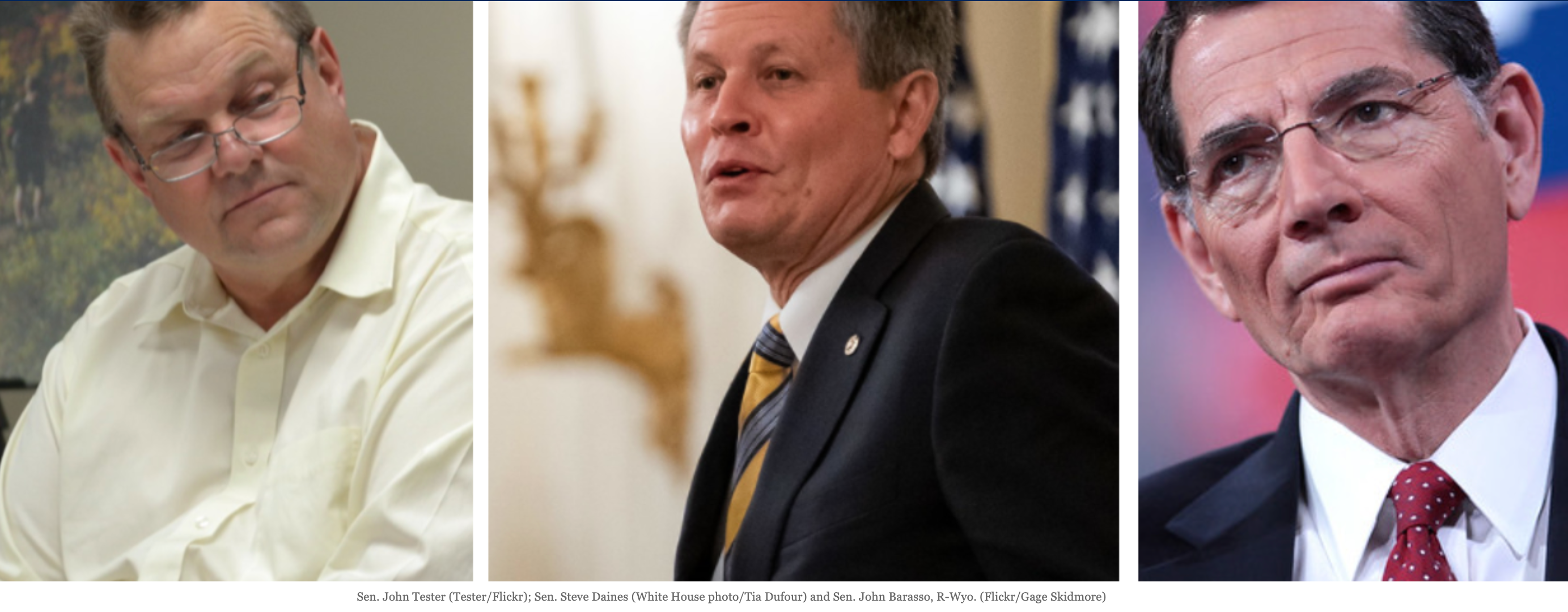
Democrats might control the legislative and executive branches of the U.S. government right now, but a small Republican-dominated Intercontinental Ballistic Missile (ICBM) Coalition exercises outsized influence in a frightening campaign for nuclear rearmament.
The coalition, comprising six senators from states that house, develop, or test underground land-based nuclear weapons, is pushing a wasteful and dangerous $1.7 trillion, decades-long plan to produce new nuclear weapons, some with warheads 20 times more powerful than the atomic bomb dropped on Hiroshima.
While the 1980s witnessed the nuclear freeze and a mass movement to demand nuclear disarmament between the U.S. and Soviet Union, the 1990s gave birth to the missile caucus, the Congressional engine careening the U.S. into a renewed nuclear arms race.
Santa Fe to exit Regional Coalition of LANL Communities
THANK YOU to everyone who contacted city officials in support of overturning the RCLC for good!
By: Sean P. Thomas sthomas@sfnewmexican.com | Santa Fe New Mexican
The Santa Fe City Council unanimously approved a resolution Wednesday to pull the city from the Regional Coalition of LANL Communities, a consortium of local and tribal governments with economic ties to Los Alamos National Laboratory.
Santa Fe’s resolution requests that the coalition return dues paid by the city and instructs city officials to begin exploring other ways to lobby the laboratory for economic opportunities and environmental cleanup.
The coalition’s board voted Friday to begin winding down the entity and close out debts, before paying back members their 2021 dues.
“I think it’s important to state while this process is going on that we approved this resolution withdrawing the city of Santa Fe from the RCLC,” said Councilor Renee Villarreal.
The coalition was formed in 2011 to advocate for sitewide cleanup and economic opportunities at the laboratory, but critics have said the coalition no longer achieves its original purpose.
Surprise! Upgrading America’s Nuclear Arsenal Will Be Stupefyingly Expensive
The cost jumped $140 billion in just 2 years. Here’s why.
BY: KYLE MIZOKAMI | popularmechanics.com
- The Congressional Budget Office (CBO) now says the cost of updating the U.S.’s nuclear weapons is $140 billion more than it estimated just 2 years ago.
- The increase is largely due to inflation and the inclusion of new, expensive projects the CBO didn’t cover 2 years ago.
- The new estimate comes as a proposal in Congress seeks to trim the nuclear budget.
The nonpartisan Congressional Budget Office’s (CBO) estimate of nuclear weapon expenditures over the next decade has jumped a staggering $140 billion in just 2 years.
The estimate, which the agency provided to Congress to give an idea of how much it will take to build new missiles, ships, and planes, as well as revamp America’s vast nuclear infrastructure, comes as key members of the legislature are pushing to cut nuclear weapons spending over the next 10 years.
Estimated Cost of US Nuclear Modernization Jumps 28 Percent
The Congressional Budget Office’s latest estimate puts the price tag at $634 billion as some lawmakers try to bring it back down.
BY PATRICK TUCKER | defenseone.com May 24, 2021
The estimated cost of replacing America’s nuclear bombers, missile submarines, and ICBMs just jumped again—from $315 billion in 2015 to $494 billion in 2019 and now to $634 billion, a 28 percent increase, according to a Congressional Budget Office report released Monday.
The report identifies a $140 billion increase in the cost of nuclear delivery systems and weapons, such as ICBMs, as the largest contributor to the jump. “Projected costs for command, control, communications, and early-warning systems have also increased substantially,” it says, adding that if full costs of B-52 and B-21 bombers were included, “the total costs of nuclear forces, with cost growth, would be $711 billion.”
It’s the second time CBO has raised their projections for the costs of modernizing U.S. nuclear forces.
Some lawmakers have balked at what they perceive as the steep price tag for modernizing the U.S. nuclear weapons arsenal. Sen. Ed Markey, D-Mass., has called for a debate specifically on the high cost of replacing the intercontinental leg of the triad. On Monday, he unveiled a new bill, dubbed the SANE act, to cut $73 billion from the U.S. nuclear weapons budget.
Department of Energy seeks to modify N.M. plant’s nuclear waste permit
Dragging out WIPP’s operations decades past the original 20-year agreement violates the social contract made with New Mexicans, said Scott Kovac, research and operations director for the nonprofit Nuclear Watch New Mexico.
WIPP is being equipped to take the waste that will be generated from production of plutonium pits for nuclear warheads, Kovac said.
“It [WIPP] was never really suppose to do that,” Kovac said.
Scott Wyland swyland@sfnewmexican.com | Santa Fe New Mexican May 17, 2021
Federal officials say a new air shaft is needed at the nuclear waste disposal site in Southern New Mexico to keep workers safe and run more efficiently.
Watch this video from the Stop Forever WIPP coalition: “When is a shaft more than a shaft?” dispelling the idea that an expansion of WIPP will mostly impact the South Eastern part of New Mexico; The new waste targeted for WIPP would be re-processed at Los Alamos. It also dispels the idea that targeting NM for waste disposal has nothing to do with our minority majority population.
The U.S. Government Hides Some Of Its Darkest Secrets At The Department Of Energy
The Department of Energy controls many ‘black projects’ that live outside of the limelight that is intrinsic to the DoD and the intel community.
BY BRETT TINGLEY | thedrive.com May 13, 2021
When it comes to discussions of government secrecy, much of the conversation tends to revolve around the Department of Defense (DOD) or the U.S. Intelligence Community (IC). After all, the U.S. military develops many of the United States’ most sensitive weapon systems used to defend America and project its power globally, and the IC gathers and analyzes sensitive information on foreign threats and external national security matters. Each year, the budget requests from the U.S. military are packed with classified and Special Access Programs, or SAPs, sporting vague code names, many of which never see the light of day. When we talk of the “black world,” most often that conversation centers around these programs and technologies suspected to be housed deep within the classified ends of the Pentagon and its various service branches.
Often left out of this conversation is the fact that there is a wholly separate cabinet-level department of the U.S. government that is arguably even more opaque in terms of secrecy and oversight than the Department of Defense. Over the last few years, allegations of secret, exotic technologies have reinvigorated claims that the DOD may be concealing scientific breakthroughs from the American public. However, if the U.S. government, or some faction within it, hypothetically came across a groundbreaking development in energy production or applied physics, a very strong case could be made that such a revolution would likely be housed deep within the Department of Energy (DOE) rather than DOD.
County Commission votes to exit Regional Coalition of LANL Communities
The exodus from the Regional Coalition of LANL Communities continued Tuesday.
“Jay Coghlan, executive director of Nuclear Watch New Mexico, agreed, adding he believed the coalition effectively stood in the way of site cleanup by supporting a 2016 consent order.”
By Sean P. Thomas sthomas@sfnewmexican.com | Santa Fe New Mexican
The Santa Fe County Commission voted unanimously to ditch the coalition after some commissioners voiced concerns that the body was no longer the proper vehicle to advocate for site cleanup and mission diversification at Los Alamos National Laboratory.
“The mission of the RCLC and the attempt of the collaboration is admirable,” said commission Chairman Henry Roybal, who stepped down as chairman of the Regional Coalition of Los Alamos National Laboratory Communities this year. “However with the progress, it does not seem like this vehicle is the best avenue to express this collaborative voice. There are so many things that just aren’t where they need to be.”
The coalition was formed in 2011 and consists of local and tribal governments. It was created to provide local governments an opportunity to advocate for jobs, environmental cleanup and other priorities at the laboratory.
Each member organization pays annual dues to be a member, with Santa Fe County at $10,000.
LANL’s move to Santa Fe means jobs, and controversy
By: Editorials / ABQJournal
Santa Fe’s relationship with Los Alamos National Laboratory has been rocky for years. The City Council, with some regularity, has passed resolutions of concern about the nuclear weapons lab’s environmental impact and radioactive materials safety lapses, the production of weapons parts in Los Alamos and the proliferation of nuclear weapons in general.
ILHAN OMAR SIGNS ICAN PLEDGE

April 30, 2021: Representative Ilhan Omar today submitted her signed ICAN Pledge to ICAN, becoming the eleventh member of the US Congress to sign the Pledge. Rep. Omar represents Minnesota’s 5th Congressional District in the US House of Representatives. Rep Omar also co-sponsor the H.R.2850 Nuclear Abolition and Economic Conversion Act of 2021 that Representative Eleanor Holmes Norton reintroduced on April 26, 2021.
Regional Coalition Of LANL Communities Struggles To Survive
Jay Coghlan, executive director of Nuclear Watch New Mexico complained that the RCLC main selling point was to lobby for mission diversification and accelerated cleanup and said he would argue that the Coalition has been a spectacular failure on both counts.
“When the Coalition was founded in 2011, LANL’s nuclear weapons budget was $1.9 billion. A decade later that budget is $2.9 billion and the total spending on core nuclear weapons research and production has risen year after year to where now it’s a full 70 percent of all funding and all of the remaining 30 percent either directly or indirectly supports those nuclear weapons,” Coghlan said.
By: MAIRE O’NEILL maire@losalamosreporter.com | losalamosreporter.com May 3, 2021
The next couple of months may determine the demise of the Regional Coalition of LANL Communities. The City of Santa Fe opted last month not to approve the RCLC’s amended and restated joint powers agreement which has been hanging out there waiting for the City’s decision since March 2019. The City is slated to decide whether to withdraw completely from the RCLC later this month.
The Taos County Commission is slated to decide Tuesday whether it wishes to continue as a member and Santa Fe County Commissioners have the same decision to make at their May 11 meeting.
Los Alamos County Council is expected to discuss its RCLC status in June which will be the first time the Council will have had an agenda item on the RCLC since it approved the amended JPA in July of 2020. The discussion is at the request of Council Vice Chair James Robinson. Councilor David Izraelevitz, who serves as RCLC treasurer, has been a strong advocate of the RCLC and has recently addressed several meetings of members of the Santa Fe City Council at the behest of Councilor Michael Garcia to encourage them to approve the amended JPA. City of Espanola Mayor Javier Sanchez also attended a Santa Fe City Council meeting to advocate and answer questions.
NNSA approves Critical Decision 1 for Los Alamos Plutonium Pit Production Project
“Recommended approach to producing 30 plutonium pits per year identified”
CD-1 approval marks the completion of the project definition phase and the conceptual design as part of DOE’s Order 413.3B process for the acquisition of capital assets. NNSA identified its recommended approach to produce at least 30 plutonium pits per year to meet national security needs.
The CD-1 cost estimate for LAP4 is $2.7-$3.9 billion, with an overall project completion range of 2027-2028. Critical equipment is scheduled to be installed in time to achieve the 30 pits per year production capacity in 2026. The CD-1 cost estimate and project completion date ranges are preliminary estimates that will be refined as the project conceptual design is matured to the 90% design level required to achieve CD-2 (approval of the performance baseline). Consistent with industry best practices and DOE policy, NNSA will set the performance cost and schedule baseline at CD-2, which is expected in 2023.
NNSA leadership and LANL will continue to review this project to improve the fidelity of the current price estimate and schedule.
###
Los Alamos lab sees two mishaps in a week
The water spill should be a reminder that the plutonium facility’s work is done by people, and people make mistakes, said Scott Kovac, research and operations director for the nonprofit Nuclear Watch New Mexico.
“Pit production will place a real time-pressure crunch on the workers and lead to more accidents,” Kovac said.
“It should lead us to consider the consequences if someone left a plutonium furnace on or something that could endanger the public…these kinds of missteps are likely to increase as the lab ramps up production of plutonium pits used to trigger nuclear warheads. Current plans call for the lab to make 30 of the nuclear bomb cores a year by 2026,”
By: Scott Wyland | santafenewmexican.com April 26, 2021
Los Alamos National Laboratory had two mishaps in one week: a glove box breach that contaminated workers’ protective equipment and a spill of 1,800 gallons of water into a vault corridor after an employee left a valve open.
The incidents were the latest in a series of accidents in recent months at the lab, as reported by the Defense Nuclear Facilities Safety Board.
In the board’s most recent report, an alarm sounded March 29 when a worker tore a protective glove attached to a sealed compartment known as a glove box while handling a piece of plutonium.
Continue reading
Sleepwalking into Nuclear War?
“People like to think that every nuclear-armed country has only one “button”, with which a president could consciously choose to start a nuclear war, after careful deliberation. But in fact there are thousands of people in the world controlling different parts of different arsenals who could independently initiate a nuclear war.” – Caitlin Johnstone
JONATHAN POWER | indepthnews.net
LUND, Sweden (IDN) — Last week on Tuesday (April 20), US Strategic Command, the part of the military responsible for nuclear weaponry and its use, posted an official Tweet that read, “We must account for the possibility of conflict leading to conditions which could very rapidly drive an adversary to consider nuclear use as their least bad option”.
This came just as Russia was pulling back its large deployment of troops on Ukraine’s border which, in turn, was triggered in part by President Joseph Biden’s decision to ship for the first time sophisticated weapons to Ukraine.
The crisis has now passed but the lesson lingers. Arguably we are closer to war with Russia than at any time since the Cuban missile crisis of 1962 (which I wrote about last week, April 20).
CHERNOBYL: 35 YEAR ANNIVERSARY OF THE WORLD’S WORST NUCLEAR ACCIDENT
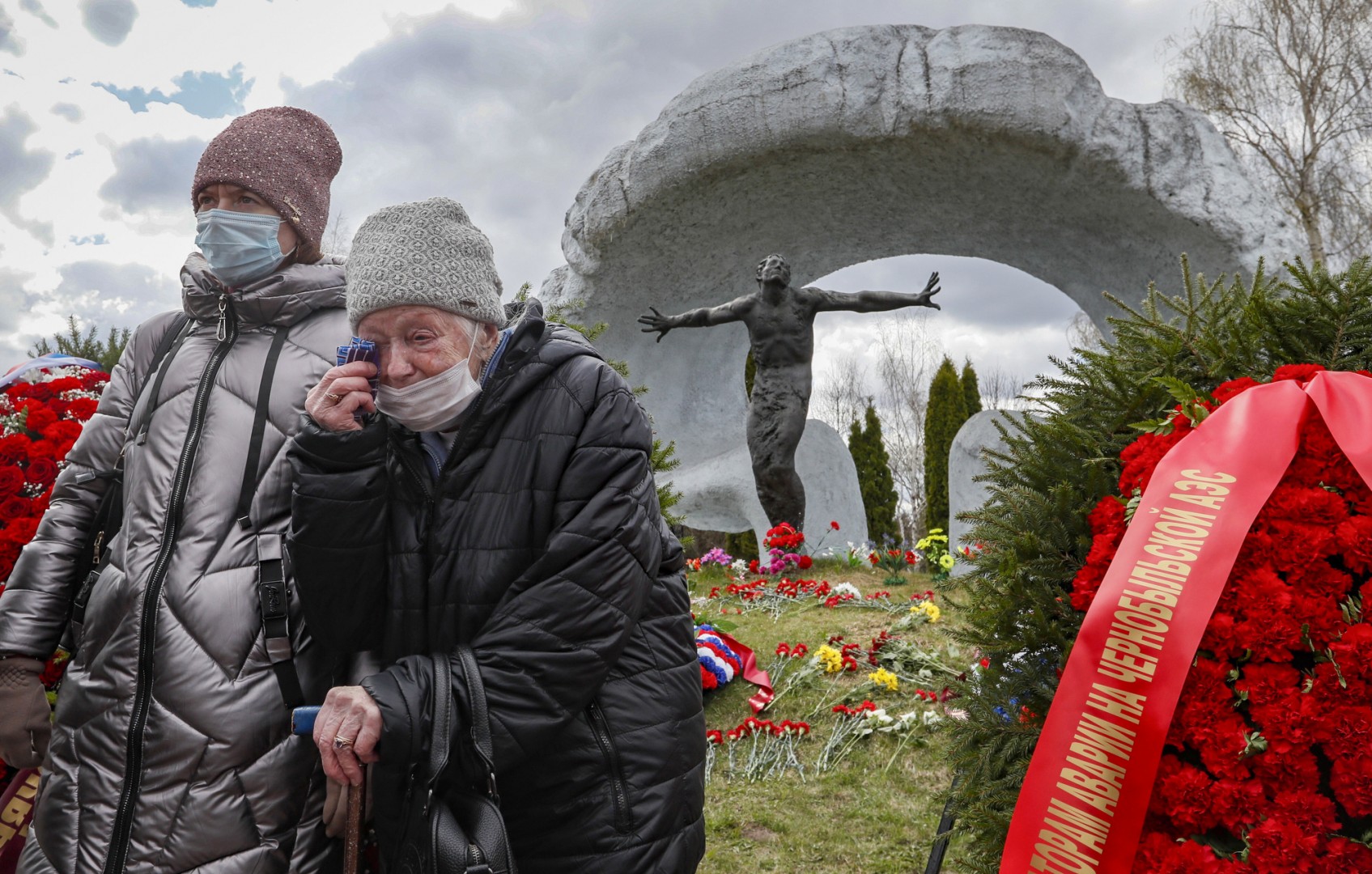
ON THIS DAY in 1986, workers ran a safety test at the Chernobyl Nuclear Power Plant in northern Ukraine. But the test went awry, starting a fire in a reactor and leading to one of the largest nuclear disasters in history. Smoke from the fire and a second explosion launched radioactive elements into the atmosphere, scattering them over the surrounding fields and towns.
Chernobyl is generally recognized as the worst nuclear accident on record, directly killing 31 people and causing widespread contamination in Eurasia. It’s estimated that thousands of people will eventually die earlier than they would have due to the cancers caused by their exposure.
Today, 35 years later, scientists are still uncovering the extent of the damage and starting to answer questions about the long-term legacy of radiation exposure on power plant workers, the people in the nearby community, and even their family members born years later.
READ: New studies highlight the possible impact of Chernobyl on genes
- Published on Science Daily, the studies—both conducted by the National Cancer Institute (NCI), a branch of the National Institute of Health (NIH)—sought to find what kind of changes the exposure to carcinogenic ionizing radiation had on those who came into contact with the explosion.
WIPP completes maintenance outage, intends to up shipments of nuclear waste post-pandemic
Reinhard Knerr, manager of the U.S. Department of Energy’s Carlsbad Field Office said WIPP will resume accepting shipments of low-level transuranic waste from DOE sites around the country and will continue to emplace the waste for final disposal in WIPP’s underground mine.
By: Adrian Hedden | currentargus.com April 26, 2021
Shipments and disposal of nuclear waste resumed at the Waste Isolation Pilot Plant after a two-month pause in the repository’s primary operations to allow personnel to complete several maintenance projects underground and on the surface.
WIPP completed 97 projects during the maintenance outage which ran from Feb. 15 to April 15, upgrading infrastructure throughout the facility.
The work involved mine operations, waste handling, hoisting, ground control, safety and engineering, and the break included a site-wide power outage to allow electrical work to be completed safely.
The Nuclear Bomb Is Ready: In Italy Soon. The B61-12 has a Nuclear Warhead with 4 “Selectable Power Options”
“It has been officially announced that the new nuclear bomb series production will begin in the fiscal year 2022, beginning October 1, 2021. It is unknown the number of B61-12 bombs that the US will deploy in Italy, Germany, Belgium and Holland to replace the B61s, whose actual number is secret. Satellite photos show renovations that have been carried out at Aviano and Ghedi bases in preparation for the new nuclear bombs’ arrival, the US Air Force F-35A, and Italian Air Force F-35A under US command will be armed with these bombs.”
BY: Manlio Dinucci | globalresearch.ca April 24, 2021
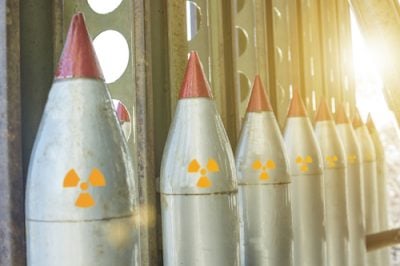
First published on December 3, 2020
***
A video was released on November 23 2020 by Sandia National Laboratories that shows a US F-35A fighter flying at supersonic speed 3000 meters above sea level, launching a B61-12 nuclear bomb (non-nuclear warhead equipped). The bomb did not fall vertically but glided until the tail section rocket ignition gave a rotational motion and the B61-12 (satellite-guided system) headed for the target and hit 42 seconds after launch. The test was carried out on August 25 at the Tonopah shooting range in the Nevada desert.
An official statement confirmed its full success: it was a real nuclear attack, proof that the fighter carried out at supersonic speed and in stealth attitude (with nuclear bombs placed in its internal hold) has the capability to penetrate through enemy defenses.
The B61-12 has a nuclear warhead with four selectable power options at launch depending on the target to hit. It has the ability to penetrate underground, exploding deep to destroy command center bunkers and other underground structures. The Pentagon’s program foresees the construction of about five hundred B61-12 with an estimated cost of roughly 10 billion dollars (so each bomb will cost double what it would cost if it were built entirely of gold).
Minorities threatened by atomic weapons plants in S. Carolina and NM, groups say
“As construction problems mounted, costs rose, and schedules slipped, (and) defendants hid the true status of the project,” the indictment said.
“…Delays and cost overruns — hidden by SCANA officials from the public and state regulators — eventually doomed the effort, making it one of the largest business failures in South Carolina history.”
BY SAMMY FRETWELL | April 22, 2021 thestate.com

A coalition of environmental groups from the southern and western United States is threatening to sue the federal government over plans for plutonium pit factories in South Carolina and New Mexico that would produce components for additional atomic weapons.
In a letter Tuesday to U.S. Energy Secretary Jennifer Granholm, a non-profit law firm said the government should prepare an extensive environmental study before deciding to establish pit production factories at the Savannah River Site near Aiken and the Los Alamos site near Santa Fe, N.M.
African American and Native American communities have been hurt by past activities at the nuclear sites, and President Joe Biden’s administration should consider how the production factories would add to that burden, according to the South Carolina Environmental Law Project, a non-profit legal service in South Carolina.
Nine environmental groups, including SRS Watch, the Gullah Geechee Sea Island Coalition, Tri-Valley Cares of California and Nuclear Watch New Mexico, are among those seeking more study.
The law project’s letter also was sent to the National Nuclear Security Administration, a division of the energy department.
“The plans of DOE and NNSA to expand this production program will saddle the already-burdened communities represented by these groups with a significant amount of nuclear waste and pollution,’’ the letter from lawyer Leslie Lenhardt said.
Her letter said the pit production efforts are in “complete contravention’’ to an executive order by President Biden that federal agencies weigh the impact their policies and plans have on disadvantaged communities.
Groups Notify Biden Admin of Impending Lawsuit Over Nuclear Bomb Core Plans
Multi-state coalition says DOE’s plans to massively expand plutonium pit production violate a major environmental law and constitutes an environmental injustice.
Jay Coghlan of Nuclear Watch New Mexico commented, “Instead of maintaining the safety and reliability of the existing nuclear weapons stockpile, NNSA may actually undermine it because all future pit production is for speculative new-design nuclear weapons. This is a colossal and unnecessary waste of taxpayers’ money on top of already wasted taxpayers’ money.”
CHARLESTON, S.C. — A coalition of public interest organizations notified (PDF below) the U.S. Department of Energy (DOE) and the National Nuclear Security Administration (NNSA) urging a comprehensive review of plans to vastly ramp up production of nuclear bomb cores at the Los Alamos National Lab in New Mexico and the Savannah River Site in South Carolina.
In Tuesday’s letter to department officials, the groups say this lack of review violates the National Environmental Policy Act (NEPA) and would saddle already-burdened communities nearby the two DOE sites with significant quantities of toxic and radioactive waste, contravening President Biden’s executive order of making environmental justice a part of the mission of every agency.
Sparks flying from nuclear waste barrel prompt investigation
Flawed packing of radioactive waste caused sparks to fly from a container at Los Alamos National Laboratory, prompting evacuation of the work area and later the underground disposal site near Carlsbad where two similarly packed canisters were stored.
By: Scott Wyland | santafenewmexican.com April 15, 2021
The sparking caused no injuries, damage or radiation to be released, according to a letter the lab wrote to the New Mexico Environment Department.
But any combustion involving transuranic nuclear waste is deemed dangerous and calls up memories of the 2014 incident in which a ruptured container from Los Alamos closed the Waste Isolation Pilot Plant in Southern New Mexico for three years and cost almost $2 billion to clean up.
Environment, Public Health On The Way To Better Protection As Environment Department Receives Budget Increase
“After a decade of budget cuts, the New Mexico Environment Department’s (NMED) base budget will increase by 21.3% for the upcoming state fiscal year starting July 1, 2021. The additional $2.8 million will be a recurring increase to NMED’s operating budget. NMED’s overall operating budget for the upcoming fiscal year is approximately $93.4 million.”
NMED NEWS | LOS ALAMOS REPORTER April 14, 2021
“Starting in July, the New Mexico Environment Department will expand its efforts to safeguard communities and our environment,” said NMED Cabinet Secretary James Kenney. “Budget is policy and this is a clear investment in the health of New Mexicans and their environment.”
NMED’s budget is a combination of state general fund, federal funding, and revenues collected for various permits and licenses. Starting July 1, 2021, the general fund portion of NMED’s budget will increase from $13.1 million to $15.9 million – an increase of $2.8 million. The remainder of NMED’s budget is $77.5 million (federal funding and revenues collected for permits/licenses).
Offline Iowa Nuclear Plant Eyed as Site of Solar Project
CEDAR RAPIDS, Iowa (AP) — A decommissioned eastern Iowa nuclear plant could become the site of a new massive solar energy project.
NextEra Energy of Florida on Tuesday laid out plans in a meeting with nearby landowners to build a solar farm near the now-idle Duane Arnold Energy Center in Palo, The Gazette of Cedar Rapids reported.
The company said the project could bring in a $700 million capital investment and about 300 construction jobs. The solar farm would stretch across 3,500 acres near the plant and would produce up to 690 megawatts of solar energy — more than the nuclear plant had generated.
“We’re also hoping to accompany that solar project with up to 60 megawatts of AC-coupled batteries,” project manager Kimberly Dickey said in the meeting. Battery storage allows a company to store energy for use during peak energy-use times.
Waste Isolation Pilot Plant aims to expand underground facility to hold nuclear waste
“WIPP is supposed to be limited. The state did not agree to 12 panels.”
By: Adrian Hedden | currentargus.com April 15, 2021
A plan to build two new areas to dispose of nuclear waste began taking shape at the Waste Isolation Pilot Plant after the U.S. Department of Energy published a report on the feasibility of adding an 11th and 12th waste panel to the underground nuclear waste repository.
Japan To Dump Wastewater From Wrecked Fukushima Nuclear Plant Into Pacific Ocean
Japan’s government announced a decision to begin dumping more than a million tons of treated but still radioactive wastewater from the crippled Fukushima nuclear plant into the Pacific Ocean in two years.
Anthony Kuhn | npr.org April 13, 2021
The plant was severely damaged in a 2011 magnitude 9.0 quake and tsunami that left about 20,000 people in northeast Japan dead or missing.
Despite Tokyo’s assurances that discharging wastewater will not pose a threat to people or the environment, the decision was roundly criticized by the local fishing community, environmental groups and Japan’s neighbors. Within hours of the announcement, protesters rallied outside government offices in Tokyo and Fukushima.
Fukushima Wastewater Will Be Released Into the Ocean, Japan Says
Beyond Nuclear | beyondnuclear.org April 13, 2021
The government says the plan is the best way to dispose of water used to prevent the ruined nuclear plant’s damaged reactor cores from melting.
As reported by the New York Times.
The New York Times also ran a companion piece, focused on the official international protest of the ocean dumping, as by the neighboring governments of South Korea, China, and Taiwan.
The Washington Post has also reported on this story.
Thom Hartmann interviewed Beyond Nuclear’s Kevin Kamps on his national radio show (“Fukushima Nuclear Fish Coming to Your Plate, Happy?”). Here is the write up:
More nuclear waste is about to be released into the Pacific Ocean from Fukushima. Where it will be absorbed by plants, eaten by small fish, who are eaten by bigger fish, and concentrated through a process called “bioaccumulation.” Pretty soon those fish end up on your plate… Looking forward to a swim off the west coast? Enjoying your fish?
Here is the link to the recording of the interview.
[Corrections: The actual volume of radioactive wastewater to be dumped in the ocean is currently enough to fill around 500 Olympic-sized swimming pools; the dumping is not set to begin until a couple years from now, not before the Tokyo Olympics.]
Environmental Racism, Environmental Justice
“When uranium mining occurred in white communities, the waste it produced was removed from the proximity of the residents. This level of clean-up did not take place when uranium mining occurred close to low-income communities of color”
By: Ruby Stigers| snakeriveralliance.org April 10, 2021
Those living near Nuclear Power Plants (NPP’s) face extreme health risks. Blood, thyroid, breast, and other forms of cancer have the potential to form due to the various types of radioactive emissions that escape the NPP’s through the air, water, and soil.
The World Nuclear Association and The Nuclear Regulatory Commission (NRC) claim that exposure to low-level radiation is undetectable and not unsafe, yet countless studies confirm the danger of the radiation that occurs during normal operation at an NPP. According to Dean Kyne and Bob Bolin, Children are especially vulnerable to this exposure.
Toxic incinerators, uranium mines, atomic reactors, and other nuclear dumping sites are generally located on cheap land where there are limited resources and little organized opposition (Jantz, p. 249). Unfortunately, because of this, they are often located in Black, Indigenous, and low-income communities that suffer the devastating consequences of improperly handled nuclear waste and pollution.
DOE Planning to Increase Down-Blended Plutonium Shipments to Waste Isolation Pilot Plant
Savannah River Site is the third largest shipper of waste to WIPP, with 1,679 as of April 3, per the latest records from WIPP.
By: Adrian Hedden | currentargus.com April 7, 2021
Federal nuclear waste managers are planning to ramp up shipments of plutonium from a site in South Carolina for final disposal at the Waste Isolation Pilot Plant in southeast New Mexico.
The U.S. Department of Energy’s (DOE) Office of Environmental Management (EM) began preparing equipment at the Savannah River Site (SRS) in Aiken, South Carolina used to package and inspect drums of the waste before shipping to WIPP where it will be permanently disposed of in the repository’s underground salt formation.
The plutonium waste will be inspected to verify that it meets the criteria required for emplacement at WIPP, which is used to dispose of low-level transuranic (TRU) nuclear waste – mostly clothing items and equipment radiated during nuclear activities.
Scotland Reaches Green Landmark – Scotland generated 97.4% of its electricity demand from renewables last year
By: Juan Cole | scheerpost.com
In 2011, Scotland’s government, urged on by visionaries like Richard Dixon, set itself the ambitious goal to get 100% of its electricity from renewables by 2020. At that time, it only only got about a fourth from clean energy sources, and a lot of that was hydro.
The report card is in for 2020 and Scotland generated 97.4% of its electricity demand from renewables last year, just a whisker less than the 100% goal.
Scotland will host the COP26 climate summit in Glasgow in a few months, and is well placed to assert climate leadership.
Scotland no longer has a coal plant, and its one natural gas plant is under-utilized and seems likely to close in a few years.
DOE’s NNSA Reveals it’s Out of Money. Flat Broke. Busted. Nothing Left for Beneficial Nuclear Non-Proliferation Program to Convert Reactor from Weapon-Grade Uranium Fuel
By: SRS Watch | srswatch.com
The U.S. Department of Energy’s National Nuclear Security Administration (NNSA) has revealed that it has spent all of our money. Busted flat. Nothing left. Nada. Zilch. Nichts.
Well, that’s what it seems like at the NNSA has notified GE Hitachi Nuclear Energy that there are no funds available to convert a test reactor in Vallecitos, California from weapon-grade uranium (highly enriched uranium, HEU) to low-enriched uranium (LEU), as part of an nuclear non-proliferation effort.
On March 25, 2021, NNSA told GE Hitac hi Nuclear Energy: “you are hereby notified that Department of Energy funding will not be available in fiscal year 2021 to complete the conversion of NTR to LEU fuel.” And GE subsequently told the U.S. Nuclear Regulatory Commission that ” DOE funding is not currently available for conversion of the NTR fuel.”
See: “GE Hitachi Nuclear Energy Americas, LLC – Annual Statement of Non-availability of Federal Government Funding for Conversion from HEU to LEU for VNC Nuclear Test Reactor (NTR) at https://adamswebsearch2.nrc.gov/webSearch2/main.jsp?AccessionNumber=ML21084A808
BUT WAIT! NNSA continues to front for boosters and contractors engaged in project to convert the abandoned plutonium fuel (MOX) plant at the Savannah River Site into the SRS Plutonium Bomb Plant (PBP) at a cost of $4.6 billion (add higher number if you wish) by 2030 (add any date you wish). So, there seems to be money available for projects dangerous to our national security – making plutonium pits for unneeded and provocative new nuclear weapons – but not a penny left to get HEU out of commerce. This confirms that the priorities of NNSA are totally screwed up and that it’s placing contractor enrichment and parochial politics above national security. Congress must make sure that the HEU conversion program is fully funded and that the Ground Based Strategic Deterrent (with W87-1 warhead) and the new SLBM (with W93 warhead) – the first new weapons to get new plutonium pits – are terminated and funded halted. As in nada, zilch, nothing.
The New Shaft Permit Modification Part 3: Your Comments and the May 17th Public Hearing
As demanded by organizations and individuals, the New Mexico Environment Department (NMED) has scheduled a public hearing on adding a New Utility Shaft to the WIPP permit. The hearing will start at noon on Monday, May 17, 2021. Hundreds of people commented on the proposed new shaft in 2019 and 2020, 97 percent of whom objected to WIPP expansion and the new shaft.
NMED allowed the Department of Energy (DOE) to bypass the public process and start digging the new shaft with just a Temporary Authorization. But after receiving so many public comments in 2020 against the new shaft and against the Temporary Authorization, NMED stopped the construction of the shaft until after the public hearing. Public comments do make a difference!
You can comment now on the proposed new WIPP shaft, which is part of DOE’s plan to expand WIPP and operate it forever, rather than developing new repositories. The plan violates existing limits set in federal law, state agreements, the WIPP Permit, and DOE’s decades-old social contract with New Mexicans.
Your comments and participation can help stop the new shaft and DOE’s WIPP expansion plan!

Santa Fe City Council rejects LANL coalition agreement
By: Sean P. Thomas, The Santa Fe New Mexican | sfnewmexican.com March 31, 2021
The Santa Fe City Council has rejected an amended joint powers agreement with the Regional Coalition of LANL Communities over concerns about the organization’s impact and one councilor’s plan to introduce a measure removing the city from the group.
“I don’t think we should just approve an updated JPA because we want to go along to get along,” said City Councilor Renee Villarreal, who noted she intends to propose the city end its affiliation with the coalition. “Some of my colleagues say we should have a seat at the table, but I think we should have it at the right table.”
The council voted 5-3 against the agreement, with Mayor Alan Webber and Councilors Carol Romero-Wirth and Jamie Cassutt-Sanchez voting in favor. City Councilor Michael Garcia, the city’s representative on the coalition, abstained.
Rejecting the agreement does not pull the city out of the organization.
Villarreal has been the loudest critic of the coalition, which was established in 2011 to give communities surrounding Los Alamos National Laboratory more of a voice in its job development and cleanup. She questioned in previous committee meetings how the city stood to benefit.
“Our values have not aligned,” Villarreal said. “I’m trying to understand changing the JPA, what does that change? How does our voice actually get heard since it hasn’t been heard the last 10 years?”
Trinity Downwinders: 75 Years And Waiting
Watch the Hearing with the House Judiciary Committee below, which occurred 3/24/21. Click HERE to visit the website. Click HERE to read the Santa Fe New Mexican article written about the hearing. See Hearing below:
‘Sparking’ nuclear waste drum at Los Alamos National Lab leads to evacuation at WIPP
“A sparking drum of nuclear waste at Los Alamos National Laboratory (LANL) led to a temporary evacuation of a section of the Waste Isolation Pilot Plant’s underground repository as officials investigated if any other drums of waste emplaced at WIPP posed a similar threat.”
By: Adrian Hedden, Carlsbad Current-Argus March 31, 2021
Investigators later found no one was hurt and no radiation was released, according to a March 12 letter from the lab to the New Mexico Environment Department (NMED) Hazardous Waste Bureau.
The lab reported it happened as workers packed a drum of low-level transuranic (TRU) waste on Feb. 26 for delivery and disposal at WIPP.
TRU waste is equipment, clothing materials and other items radiated during nuclear activities.
During the packing process, two high efficiency particulate air (HEPA) filters were placed into a drum, followed by a “metal waste item,” read the letter from the lab.
The item tore the bag containing the HEPA filters, and sparks were observed coming out of the container when the item contacted the filters.
Nuclear News Archives – 2021
Nothing Found
It seems we can’t find what you’re looking for. Perhaps searching can help.

